Israel & Jordan, February/March 2013
Don’t get me wrong, this isn’t some self-glorifying introspective barefoot pilgrimage at dawn to the top of some mountain in the back of beyond, that may have once been where some holy man said something fundamentally trite. Rather, it’s a trek through history, where three of the world’s major religions (and a few smaller ones) meet and divide, and, on a more firm basis, where humans have been living and fighting with each other for the best part of 6,000 years. This is part of the land where civilisation itself started, where farming and writing were developed, and where the first cities were founded. (Granted the *really* early stuff happened a shekel‘s throw away, in either Egypt or Mesopotamia. [Given that all the important Mesopotamian cities are generally inaccessible, this is the nearest I get to those times!] And of course the religious history itself is notable – though using religious texts as a travel guide is probably not a great idea. If nothing else, the placenames will be two-to-four-thousand-years out of date!
It is true however that I wouldn’t necessarily consider myself to be deeply religious. Despite what people seem to imagine, I’m not an Atheist, although this is rather more to do with semantics than belief – I’ve tended to feel that nature (and the physical world itself) fulfils many criteria of ‘divine power’, albeit one which has no direction or sentience, and therefore while needing to be respected, there is no point in worshipping it because it doesn’t have a consciousness in which to ‘know’ that you even exist. I don’t think there’s a term for that …
What it all means of course is that I’m going to be travelling around the centre of the Abrahamic Religion, as pretty much a complete neutral. I am tempted, for the avoidance of doubt, to wear a symbol of a distant religion so that people don’t assume; probably something Buddhist!
All that is, of course, flannel. The real reason for going is because my passport runs out in mid-2014. Given that I’m planning on renewing it at the earliest opportunity, and that many countries look unfavourably upon a passport with an Israeli entry/exit stamp in it, it makes rather a lot of sense to go to Israel now, on an old passport, and not have to worry about countries letting me in on my new one. Because of course Yemen, Syria, and Iraq are all on my list of places to go in the subsequent 10 years (!). Disclaimer: One of them is on my list for 2014. And it’s not Yemen.
The trip is being attempted on my own, with no knowledge of Hebrew and minimal knowledge of Arabic, with just hand-luggage, and again, a successful trip will be defined as once where I come back without having been shot, arrested, or run over by an eccentric driver.
Day 01: Saturday 16 February –
Caffeine-free and Zombiefied
Constantinople is a very long word, can you spell it?
This is a very old and annoying riddle, the answer to which is ‘i.t.’. Anyone who asks it of someone deserves what they get, quite frankly.
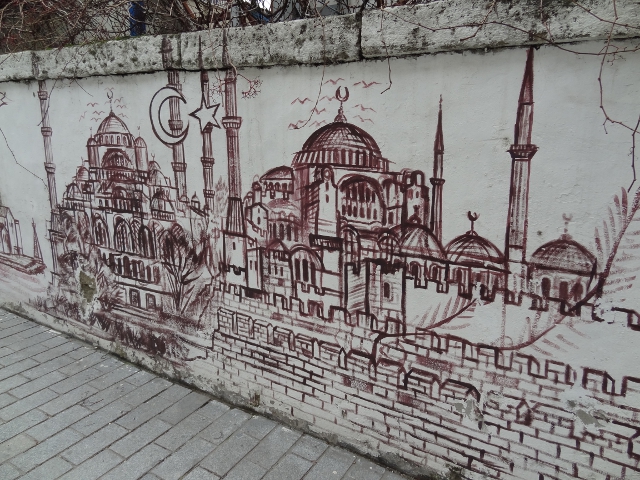
Artistic representation of Istanbul, on a wall down a side-street.
I’m updating this at only about 6.40pm, whilst sat in the (remarkably small) departure area at Istanbul’s smaller, low-cost airline, airport which is located on the Asian side of the Bosporus. I realise that the day isn’t quite over yet but let’s be honest, my day finished several hours ago!
Firstly, I need to give a special mention to my esteemed work colleague Mr David Hardy esq for driving me to the tram stop yesterday evening. The journey couldn’t have been done without him (!). This note is in place because he complained last time that he hadn’t been mentioned, so … :p. I also need to mention in dispatches the 6.37pm train from Nottingham to Norwich. I’ve now caught this train on three successive holidays, and on each of those occasions it has been over 30 minutes late, Yesterdays was even weirder since it’s supposed to have come from Liverpool but was already standing in the station at 6.15pm … turns out that it was a new train as the one from Liverpool was broken, so had to terminate in Nottingham. And was at least 15 minutes late doing so …
But I digress.
It does seem strange that the last foreign city I went to was Sarajevo, in Bosnia, which I thought looked like how I’d imagine Turkey would look, since the very next city is Istanbul, which is how Turkey does look. 😀 This wasn’t planned at all. You can tell …
It also seems strange to note that it was exactly the same weekend this time last year that I departed for SE Asia!
There’s a number of things I’ve discovered over the course of the last … ‘many hourly period’. The first is that, regardless of how clever and useful it appears, having a stopover in any city isn’t time-effective if you arrive in said city before anything has actually opened … my flight into Istanbul landed at 5am and by 7am I was wandering through the chilly, empty, streets of the district of Sultanahmet, because there wasn’t anything else for me to do … meh.
The second, and related, point is, regardless of how clever and useful it appears, having a lengthy stopover after a short overnight flight (less than 4 hours) is not good for the body. I don’t really sleep well on planes anyway, and the length of the flight wasn’t really suited to more than a doze, so consequently I’ve spent most of the day in a kind of zoned-out vacant state. And, regardless of being in Turkey, I hate coffee!
That’s not to say that everyone else in the city wasn’t. Have I ever said how much I hate tour groups? Get out of the freakin’ way, you knobs, you don’t own the corridor; don’t push in front of me – just because you’ve got a tour guide doesn’t mean you’re bloody important! And other related stories that play in my head but which, being British, I’m obviously far too polite to act out. Today, at least.
And, while we’re on the subject, I wasted an hour or two trekking up and down Istanbul’s equivalent to Oxford Street, surrounded almost entirely by other vacant souls ploughing in front of me or just generally being a nuisance. Except these were the locals. Scary.
Actually, that raises a point, whilst we’re on about the locals. I have a suggestion for them, it’s only a small suggestion, but one that they may do well to take a note of. SMILE!!!!!! They all looked so miserable, dour … not a friendly face amongst them, really. The only person who did smile was the lady who changed some money for me, and that was only because she was amused by the way I bounced up to the kiosk. Evidently no-one had smiled at her much today in the first place either.
So, Istanbul.
Well … it might be quite a nice city when they finish building it. There were development works everywhere (which meant of course those big boardings along walls and next to pavements etc, that generally look ugly). It’s also somewhat more expensive than I’d imagined; I mean granted I got a small meat kebab wrap for the equivalent of £2, but … I dunno, maybe I’m comparing it with Bosnia but (although I wasn’t in the market for dinner) looking at menus of restaurants, there wasn’t much in the centre of the city for less than £8-£9. Unless you looked hard and were very specific – most places for instance had ‘baklava’ on the menu, but as a dessert option with three pieces for around £6. If you only wanted one as a snack, that was trickier. But I got there!
I saw the outside of a lot of buildings. This was mainly due to them not being open, and then me being too knackered to venture back there once they were. I also saw a number of examples of mural art; not as many as in Brussels, obviously, but still more than I’d have expected. At one point even there was a crowd gathered around a couple of people who were in the process of doing the artwork on a spare wall.
Two tourist attractions I did go to though were the Hagia Sofia, and the Topkapi Palace. Both 25 Lira (work on the basis of there being 5 Lira to £2). And both exceptionally full of tourists, obviously, although I went to Hagia Sofia around 10am; when I went past at just gone midday, there was a long queue outside …
This is an impressive achievement; the Hagia Sofia is HUGE, especially when you consider it is, more or less, a glorified cathedral. It does have one of the largest domes of any building in the world, and when you consider that it’s also pretty ornately patterned, it does give you a very real sense of impressiveness. It was a cathedral from Byzantine Empire days, but was built on top of a previously-existing ancient Roman temple. The view of the main concourse and the ceiling from the upper galleries was also impressive, even despite part of the main area being renovated …
It’s also been a mosque. When the Ottomans took Constantinople in 1453 AD, they (very quickly!) converted it to Islamic ritual standards. This means that the decoration on the inside of it is a rather odd mix of traditional Christian art and Arabic writing.
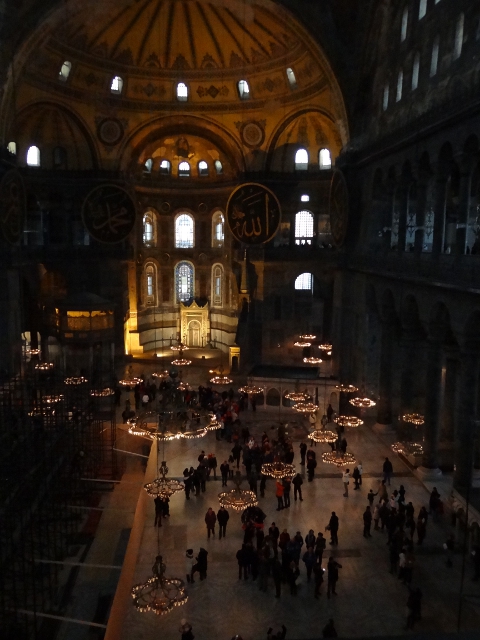
View of the inside of the Hagia Sofia.
Just round the corner from it are related mausoleums of several sultans and their families, which not only were the quietest places I encountered in the whole city (once everything was open, natch!) as few tourists went in them and those that did stayed incredibly silent, but also had the smoothest carpet I’ve ever walked on (felt similar to a snooker table, actually)!
The other main tourist draw I went to was the Topkapi Palace. This is also HUGE, but in a different way – rather than being one very building, it’s a large number of small and reasonable sized buildings covering a vast area. Used as both a residence and a seat of government (although in olden times, the two were often the same when you were the ruler. One might even suppose that mediaeval Kings and Sultans and Emperors almost started the trend to ‘work from home’! Indeed several British Kings combined the two and both ‘moved house’ and ‘worked while travelling’ to other people’s castles and set up their court there, for a few months.), many of the buildings are now little ‘museums’ showing things like Ottoman armour, weapons, spoils of war, medals, etc. Oh, and Mohammed’s tooth.
Yep, there were a number of religious items on view as well, including several of the weapons used by immediate followers of Mohammed, the very bowl that he drank out of (once), and, uhm, Moses’ rod. No, the one he used to part the Red Sea with, you dirty-minded individuals. Yes, that one, the very same. Dated to about the 17th century BC. It looked in rather good nick actually, well, you could tell what it was. A dirty great big stick. Yeh …
I could have seen and done a lot more, but to be honest I was knackered, and I was finding it difficult to focus on some of the panels in the Topkapi museums. Though them being written in dark colours on a transparent panel laid in front of a dark wall with low lighting didn’t help matters. I had a wander through some of the rest of the city, but didn’t do or buy anything much, apart from the aforementioned snacks (I never eat much while travelling, dunno why, just never feel hungry!).
This includes carpets. Now one of the things that is often warned about when it comes to Istanbul are the people who try to commit to your buying a carpet. This particular outfit had a clever way about things – a Turkish man with an English-origin woman, who can thus appeal to both sides of the argument. But now look at it from my point of view; I’m slightly chilly (their opening gambit as they walked past was ‘aren’t your toes cold?’. Since I’d left the UK with snow still on the ground in small patches, the answer’s clearly ‘no!’), I need a sit down, and they’re offering me a free apple tea. Personally I think there’s only one winner here – I get to learn about carpets, in the warm, at their expense, and they get merely the frustration of a bloody-minded Englishman. Apparently (I asked them afterwards) the easiest nationality to convince are the Germans. Not sure why.
Now, hopefully by the time anyone reads this, they’ll have let me in to Israel. Interesting that it says ‘to fly to Israel, check-in early as you might be asked lots of questions at check-in’. Except that I checked-in online. And wasn’t, at any point, in the airport. Yet, anyway …
Also no idea where I’m overnighting tomorrow. Usually I leave it at least a week before getting to that stage. I’d have sorted it out today except that I’ve had no internet since leaving the UK!
Day 02: Sunday 17 February –
People are the lights of every city
You’d be paranoid if everyone was plotting against you!
Trad., attributed to Jim Hacker, in ‘Yes (Prime) Minister’.
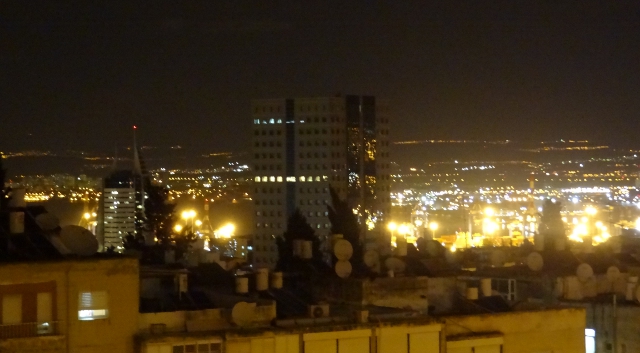
Haifa by night. The view is apparently better from higher up. Feck that!
It is believed that nothing man-made is visible from space. This is a lie; there are at least two things created by humanity that can be seen by satellites. One is half of The Netherlands, having been reclaimed from the sea by human intervention. The other is more generic – it is the fact we Are. Our cities are visible from space, our streetlights and home lighting. Although the individual light isn’t seen, the overall effect of light is very easy to spot.
And from the distance of space, there is no difference between us. Lighting does not differentiate between black and white, rich and poor, Theist and Atheist, optimist and pessimist; we are all the same.
It’s curious therefore to note how much people perceive themselves to be different, and how easy it is to stand out from a crowd. Like walking around, in quick succession, the Israeli, tourist, and Arab parts of the city of Akko, seeing how different they look and how different people act in them. Even, sometimes, the same people. The stallholders enticing you in with cries of ‘Falafel King! Have some! It’s like Viagra!’ are the same ones as being shouted at from three floors above by a woman on a balcony, because you’ve parked in the wrong place.
Evidently, I made it into Israel without any hassle. Indeed, it look longer to get off the aeroplane than it did to get through immigration. Straight to an official, asked me why I was in Israel, and what my job was, and then sent me away. The most difficult bit was sourcing some cash as all the cashpoints in the airport were ‘temporarily closed’. One suspects that they’d been closed for Shabbat and no-one had flicked the switch to make them work again … :p
Indeed, the only problem I’ve had all day has been at one of the museums in the city of Akko, who denied me entry. That’s not *quite* true; what they said was that they’d have to check with the Defence Ministry to see if it was all right to let me in. This would take half an hour. It was 4pm and the museum closes at 4.30pm, so …
Not sure what it was that caused the concern. They highlighted the entry/exit stamps from Dubai, though when they looked through my backpack and found the Arabic phrasebook, that probably didn’t help matters. In actual fact though, the guards seemed genuinely bemused at the fact that someone non-Israeli was interested in going into the museum anyway. I suspect partly it’s because I was British – it was a museum dedicated to the ‘Hebrew Resistance’ underground movement in the pre-1948 era, and is located in what used to be the prison that we Brits locked them up in … Hey, at the time we considered them a terrorist organisation! And one man’s terrorist is another man’s freedom fighter. I shall refrain from going into a whole ‘Mark Thomas’ performance here though …
You do quickly get used to the security here, though. The most evidence I’ve seen of it has been on the railways. It’s a bit like being at an airport – you have to put your bag through a conveyor belt scanner, and then walk through one of those metal detector type scanner things, just to enter the station (oddly, I had to do the same just to enter the airport in Turkey yesterday evening). It’s all for the good of course …
Speaking of defence … it being a Sunday means it’s the start of the week here, and the train to Akko from Tel Aviv was full of soldiers, returning after their weekend break (I forget whether the break is a break from soldiering or a soldiering break from their normal lives). I did think of a number of my female friends at this point …
I was also musing while at the gate waiting for the plane to Tel Aviv last night. Was I the only Brit? Probably not. Was I the only Gentile? Perhaps. Then it dawned on me; I was probably the only man on the plane who hadn’t been circumcised. See, we are all of us different … !!
I didn’t see much of the people I shared the one night in a dorm hostel with. Even though I’d rushed through the airport, and having missed the hourly train to Tel Aviv, caught a taxi (driven by a moody, dour chap who didn’t even know where the road was that I wanted to go to), by the time I got to the hostel (just past midnight), the other three had gone to bed. The receptionist who let me in was a helpful cute young lady with an American accent, but even she couldn’t do anything about the dodgy bathroom with the dripping and loose tap fitting, and the dorm door that didn’t unlock properly. Three times during my time I had so much difficulty getting through it that one of the women I was sharing with had to open the door for me from her side. It would only have been twice but the one time I specifically left the door unlocked, someone else had come back to the room in between times and locked it …
I have, however, seen more of my host for this evening. Although I’ve done it unofficially before, with penpals, this is the first time that I’ve ever properly done Couchsurfing! After some flittering between Haifa and Akko over the last few days, I finally managed to find a host for me in Haifa (my original plan) – a chap called Michel. His apartment block is very close to a small pub in Haifa that serves decent food and real ale (LiBira), so I waited in there for him to arrive once I got to Haifa. They brew their own beer, but seem to have a couple of guest ales too. I wasn’t paying attention to what I was drinking so only really made a note of two of the beers I had. meh. See, if I hadn’t couchsurfed, I’d have never have known the pub existed! This is this holiday’s ‘jazz bar’ moment!
Couchsurfing. A means by which people looking for mattresses on floors to sleep on can meet up with people who are willing to let perfect strangers into their house. Oddly, it seems to work; it’s all built on the concept of trust. And when people trust random people enough from the other side of the world and a completely different culture to allow them free entry into each other’s standard lives without knowing for sure if either party is a notable serial killer, then this can only show the good side of humanity. Or that naivety is right 99 times out of 100. Either way, it’s cool 🙂
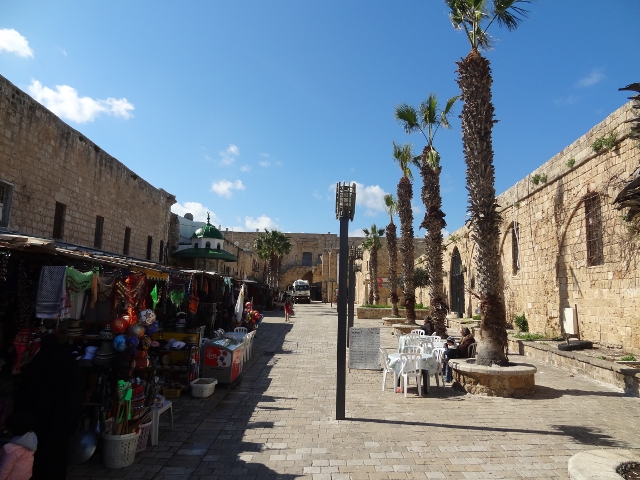
On a different note, this is where I had lunch in Akko.
Most of the day however involved me trekking through the streets of Akko on my own. (And then up a great big hill in Haifa, because the pub didn’t open till 7pm and I got there at 6pm. It was quite a tricky place to find too – the road wasn’t listed on my map, and when cross-referencing with Planet Leesti HQ (Northampton branch), the roads on my map that were listed, weren’t listed on her map! Then, after we thought we’d got it sorted, and I was in Haifa, the roads didn’t seem to make any sense anyway! And the fact it was closed didn’t help matters since it wasn’t lit up and obvious where it was … but anyhoo. I decided to go for a walk around Haifa and try to take a picture of it from above – Haifa, like San Francisco, is built at the bottom of, and along the sides of, a steep hill. I eventually found somewhere, but I think by doing so I managed to disturb and confuse a couple of young lovers on a bench …). And now I have a blister on my right foot the size of the Gaza Strip.
Akko is an ancient crusader port, centre of the Knights Hospitalier during those times. It’s built around a natural promontory of land, so was constructed so that the city walls only had to cut off some of the land – most of the protection for the city was provided by the sea. And (admittedly there’s some reconstruction going on, but) the city walls are still pretty much there, as are remains and ruins of other buildings and ephemera. These included the large central citadel, a couple of old forts along the coastline, and the ‘crusader tunnel’ that linked the centre of the city with the port area, to provide an easy means of transporting goods (and people) into the heart of the city.
And falafel. My day was filled with falafel. This is not a bad thing, though Michel suggests I ought to vary it a bit tomorrow and go with Houmous.
Day 03: Monday 18 February –
It’s not the End of the World, you know!
Remember kids, bringing about Armageddon in your own home is dangerous.
From ‘Good Omens’ – Terry Pratchett and Neil Gaiman.
There is a literary concept, one I may have alluded to before in a previous diary, but I’m not quite sure when, known as ‘pathetic fallacy’. It is the situation where the environment, and specifically the weather, will often reflect the plot/emotions of the characters. This is why there are standard clichés such as solo Private Investigators will always work on cold, wet, evenings, why horror movies always take place in thunderstorms, and so on.
Today, it rained quite heavily. Specifically, and only, it rained en route to, and coming back from, an ancient hill-fort called Tel Megiddo. This reflected the futile effort the journey was. And no, I didn’t bring a coat!
Now, one of my friends in the USA says that her ancestors got up so late they missed their boat from Ireland – the boat in question being the Titanic. Taking all the history and theology into account, it’s retrospectively possible what happened today might well trump it.
But first let me talk about Tel Megiddo. Famous for three battles in history (the most famous being one in the 15th century BC, where the Egyptians routed the local Canaanite forces), it was quite a notable ancient city-state of the Levant, and being perched on a hill surrounded by flat plains, was quite a strategic location.
However, depending on who you ask, Megiddo is also the site of a fourth battle, one that makes the other three pale into insignificance. However, it hasn’t happened yet. The Greek name for Tel Megiddo may have been Armageddon – yep the End of The World is a place not a time. Some people say that the plains surrounding Megiddo will be where the final conflict between Good and Evil takes place, as depicted in the Revelation of St John the Devine. Conversely, others say that the Revelation is evidence that John was particularly partial to a certain genera of mushroom …
If the battle does take place one day, I think it’s fair to say that, unlike the Israeli Army on a Sunday, the two forces will not be headed there by public transport. The main stop for Megiddo is ‘Megiddo Junction’, around 1-2km away from Tel Megiddo at the other end of a two-lane highway with no pavements. In train parlance, it’s a ‘Megiddo Parkway’ without a Park-and-Ride. The nearest town of any significance is Afula, maybe 6km away and buses are … irregular.
And by the time I got there, it was closed.
Seriously. How can I possibly be late, for Armageddon?! I got there just as they were closing the doors. Not ‘last entry’ doors, but actually the gates and everything. Apparently they close early during the Winter … meh. But they took pity on me, gave me water, and a lift back to Afula. Bit of a waste of a couple of hours, but never to mind. I just have to decide whether to go back at any point before heading to Jordan (on Wednesday); tomorrow I’m supposed to be planning on going up to Galilee and pretend to be Jesus…
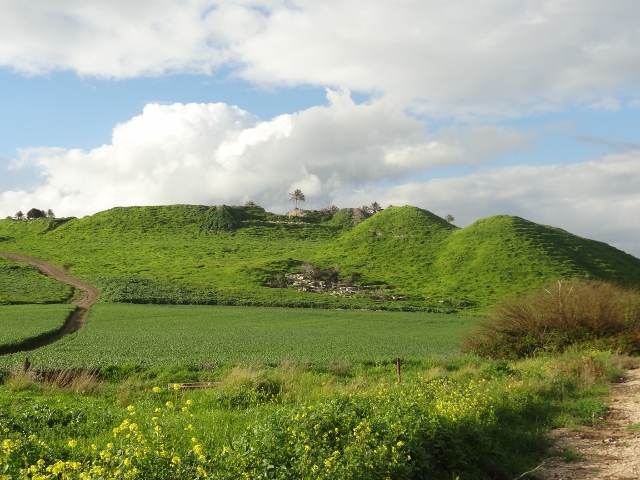
This is as near as I got to the End Of The World.
Anyway.
Evidently I survived the couchsurfing experience. I’m currently in Nazareth – one of those cities that everyone’s heard of but probably less people can place. And probably less people could describe; it’s entirely not what you’d expect!
My first impressions weren’t terribly favourable, but once I hit the old city it grew on me quite quickly. Basically, it’s an Arab city. It’s somewhere that wouldn’t feel out of place the other side of the border. The very centre is quite touristy, but it goes out a long way in a rough urban sprawl. It’s also situated at the top of a hill – well, this feels more like a mountain than a hill – the roads into it are incredibly steep and curvy. What’s really odd is that it feels like it’s a mountain on its own; it seems completely surrounded by flat plains!
As a side note, I seem to be spending most of my time thus far in amongst Arab Israelis rather than Jewish Israelis, and I’m not entirely sure I know why. It’s weird; the bits of Akko I explored were predominantly Arab, my couchsurfer hosts last night tended towards the Arab side, and now I’m in what feels like a Palestinian backpacker hostel the other side of a souk, and hidden away amongst the narrow passages of the old town. (I presume it’s a Palestinian-influenced hostel – one of the notices is ‘Tourism in the West Bank – why you should visit’!). Naturally enough my food as tended to Arab influences; granted, falafel and hummus are common across the whole of the Eastern Med (and Israel and Lebanon had a bit of a rivalry a few years back as to who could make the biggest pot of hummus!), but I seem to be eating in places where the first writing style is Arabic rather than Hebrew. Tonight’s meal for instance was definitely Arab (I’d suggest Lebanese, in fact, as one of things I had was I believe called ‘Leban brick’. It was hummus-like, slightly spicy, and fab!), the hummus itself was probably the best I’d had, and of course I had sugary, strong, mint tea! [which they gave me for free. I was the only person eating there, never mind the only tourist!]
Ah yes. Israel is a country of many languages. I saw a sign in Akko with, not only four different languages, but four different alphabets! Nearly everything is in Hebrew. Depending on where you go, the second language written is either Arabic, English, or Russian. There seems to be a very big Russian influence in Israel – this is presumably because of the vast numbers of Jews who ended up trapped by the Soviet Union after WW2, and who were eventually allowed to ‘return’ to the Jewish homeland.
Prior to the failure to initiate Armageddon, I’d come from Haifa by bus. Left my couchsurfing hosts around 9am-ish (they had to go to work), and had an amble through the city in the daylight. This again involved clambering up the massive hill Haifa stands at the edge of, including at one point going up about 70 steps only to find it was a dead end! (The roads follow the contours of the hill, as most roads do, but between the roads, and where many of the people live, are staircases that directly connect the roads in a straight line. Obviously these staircases are steep … !!).
I actually ended up at the same place as I had yesterday – but this was intentional. Israel has several ‘very holy’ places to a number of religions, but one of the ones that’s rarely in the news is the Baha’i religion. This was a 19th century ‘breakaway’ sect from Islam, in modern-day Iran, by someone (later called the ‘Bab’, or ‘Gate’) who claimed to be the next prophet. This obviously went against Islamic principles as Mohammed is, in perpetuity, the last prophet. In a sense, this chap – Siyyid `Alí-Muhammad – was a kind of ‘David Icke’ of his day. This is a scary thought. Anyway, the ‘Bab’ was unsurprisingly executed in 1850, but by this time he’d managed to gather himself a large number of followers, who managed to (secretly) obtain his body and take it out the country.
Meanwhile one of the Bab’s followers started to make a name for himself too, eventually realising he was the designated follower of the ‘Bab’, and took the name Bahá’u’lláh. He was banished by the powers that be from Persia, firstly to Constantinople, and eventually to Akko. He died there (and Akko is another very holy place for the Baha’i), but the remains of the ‘Bab’ were given their final resting place in Haifa.
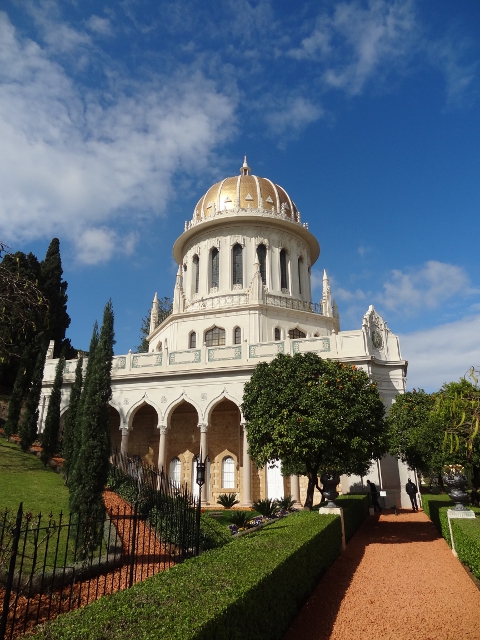
Today’s holiest site. And I bet you’d never even heard of the Baha’i before today!
And what a resting place! The tomb is a large white dome, actually quite similar to an Islamic Mosque, and very white. It lies about halfway up the mountain of Haifa, and at the bottom of a long strip of perfectly manicured and designed gardens that stretch from the very top of the mountain. It’s a very weird strip of greenery straight up the hill, surrounded by the white and cream of the buildings of Haifa – very impressive. And the views from the very top of the gardens are apparently superb. I’m not *that* dumb to walk it. And yes, there’s Israel’s only subway/metro that runs underneath it but, well, meh!
I feel like I’ve done a lot already – it feels weird to think that I’ve only actually been in the country for two days!
Day 04: Tuesday 19 February –
Am I defined by my Nationality?
“Liverpool? Can anything good come from there?”
What Nathanial never asked John (Lennon)!
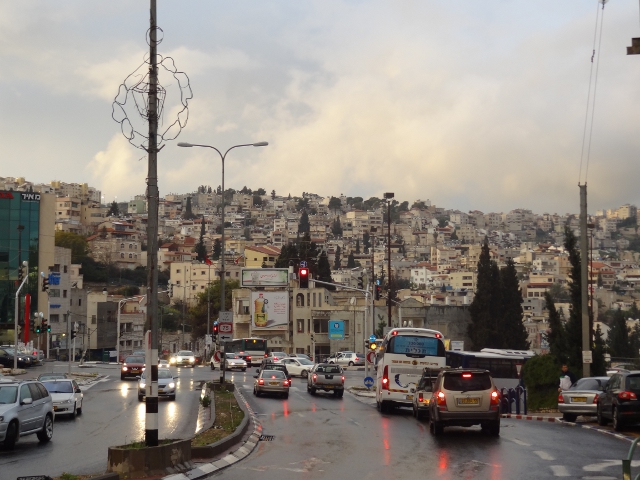
I bet you never imagined Nazareth would look anything like this!
There is some dispute as to the historical accuracy of some aspects of the apparent history of Nazareth. One of the major concerns is whether or not Nazareth was even populated at the time that ‘Jesus of Nazareth’ is said to have lived. There is clear evidence that the general area was farmed and lived in, and some towns not too far away certainly existed (there is ample proof of people living nearer to the Sea of Galilee), however contemporary references outwith scripture are hard to find. Some even believe that the original word written in the scriptures wasn’t Nazareth at all, but a tribal or descriptive synonym (‘Jesus of the Nazarenes’, potentially).
Not that any of it matters to the modern-day tourist. Nazareth is full of a considerable amount of biblical cheese, including not one, but two churches built on the site that the angel Gabriel came to Mary to announce her forthcoming pregnancy. “It’s not your baby, Joseph, it’s God’s.”, to which Joseph replied “That’s cool, we can raise him together.” This is not the answer that most people would have given, nor is it an answer that would go down terribly well amongst the average viewing public of Jeremy Kyle.
But back to the churches. They are at opposite ends of the old town. Now, granted there’s a certain amount of supernatural and divine power going on here, but not even God could make his messenger appear to the same teenage mother-to-be in two different places at the same time. (And no, he’d only give the message once. Much like the ending to the movie Se7en, it loses its impact once you know what’s going to happen. Still a cracking movie, mind!). The large church/basilica, of the Annunciation, lies at the South end of the old city, and is overly grandiose in style, no expense spared, with murals along the outer courtyard walls representing all the countries who’ve shown their support (presumably there’s a donation involved) to the building. Scotland and Wales are both there. England, I didn’t see … Inside the ornamentation continues, again on a large scale; there is an upstairs too! As you might have gathered by now, this is the Catholic one. At the North-East end of the Old City lies a much smaller church, with a couple of relics and a holy spring. This is the Eastern Orthodox church, very well decorated (what it lacks in style it, er, lacks equally in taste), and was full of pilgrims from Serbia.
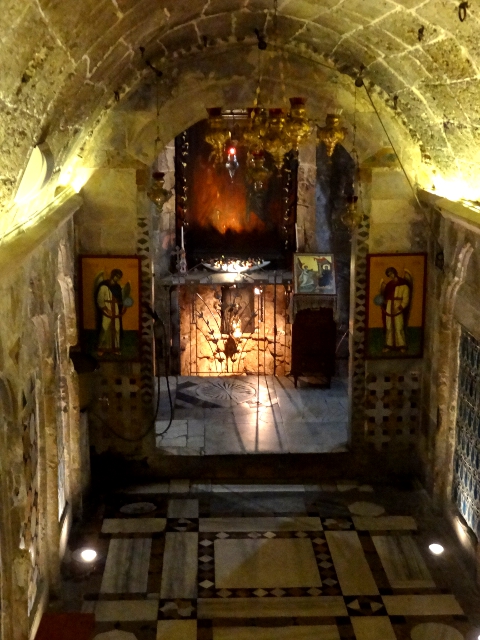
Leading down to the shrine and the “spring” in the Orthodox church.
But ‘yer man’ himself is also represented. Jesus Christ is to Nazareth what Robin Hood is to Nottingham – a semi-mythical figure who is attached to a nearby large town by traditional association (the general feeling is that Robin Hood came from somewhere near Worksop, but interestingly his nickname of ‘Robin of Loxley’ suggests a more Northern origin; Loxley is a suburb of Sheffield, on the way to Barnsley. This may be unconnected, or it may not. Sherwood Forest and the shire of Nottingham were huge areas, but I doubt they stretched *that* far!). And in garish fashion, Jesus’ life in Nazareth is depicted in the ‘Nazareth Village’ museum. This is a ‘living museum’ showing life in first century Judea, whereby there are people dressed up and acting as carpenters, shepherds, weavers, etc to give you a feel of what life would have been like for a teenage/twentysomething Jesus. Scripture is strangely silent on the matter, so legends of him travelling around Europe and even to Britain have arisen.
(On a side note, another person believed to have travelled to the UK is Joseph of Arimathea, having taken a sample of the true cross/crown of thorns/etc and laid them down in Glastonbury. Why he should have done this is unclear, although as they both stand on high hills surrounded by flat plains, one assumes he felt at home. Quite where home was is unclear in any case – Arimathea has never been found, either in physical evidence, or indeed in any written accounts other than scripture. So that’s two places that aren’t certain; I’ll reserve judgment on Bethlehem until I see the signpost welcoming me in!)
Anyway. This ‘Nazareth Village’ museum is, well, it’s a bit tacky. Almost everything is a reconstruction (including any buildings), which is fine, and they run it genuinely like they are 2000 years ago – so they grow and press their own olives in the traditional ways, they make wooden items, they roam sheep … There is the religious aspect to it too though; now it may have just been because I was tacked onto the end of an American tour group who seemed to be on a Biblical tour through Israel, but the museum tour guide was very much into quoting passages of the Gospels which the group were fond of repeating and ‘Amen’ing. I may not have found a religion yet, but I know that American evangelical isn’t it! The tour guide at the museum also tended to refer to me as the ‘British’ man or the ‘Brit’, because it was an easy way to identify me from the rest of the group. Apparently names are hard.
Interestingly that very same tour group, a couple of hours later, were directly behind me in the Orthodox church in Nazareth.
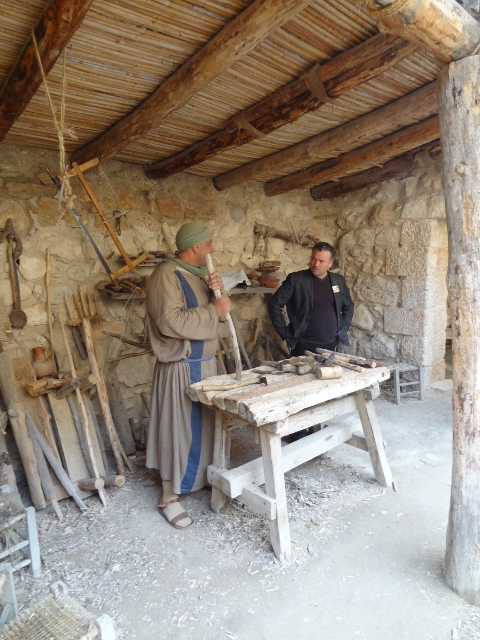
Carpentry Without Cables, with Joseph.
Names were also hard for the lady from the hostel who took some of us earlier in the morning for a ‘meet the people’ type tour of Nazareth Old Town. Here, I was referred to as ‘The Englishman”. Note the difference. This may have been my fault for inconsistent descriptions. People are asking me a lot ‘Where are you from?’, or ‘What nationality are you?’. To the first, I tend to say ‘England’, to the second ‘British’. While technically accurate, this also leads to confusion.
I should already have been primed for this; in Haifa, I was trying to explain to my couchsurfing hosts (and the lady serving behind the bar) what the difference was between ‘Great Britain’, ‘the UK’, and ‘England’. In that instance, beers may or may not have been helping comprehension, but they helped the explanation. I actually went even further; one of them had heard of the ‘Isle of Man’, so I had great fun describing how that wasn’t any of the above, and neither Independent nor not Independent. Yeh, fun times … Mmmm, beer … 🙂
Anyhoo. This lady was American, and volunteering at the hostel. It’s that sort of hostel; it seems to be a meeting point for people from all over the world. I was ‘The Englishman’, as stated; on the tour also were an American man called Linford, an Indian woman with Norwegian nationality called Sangeeta, and 5 members of a Peruvian family. Eight of us. And apparently names again were too hard to remember (!) … Interesting tour though, as we were introduced to the types of people who lived and worked in the old city, and to a few of the places that people don’t normally see (including a derelict house with unusually-designed ceiling patterns).
Because that first tour lasted longer than I’d anticipated, I didn’t think I’d have time to wander up to the hills around Galilee to walk around where Jesus preached and gave miracles (like feeding hordes of people with merely bread and fish. Sounds like soup to me), hence how I went to the Nazareth Village museum instead. So I didn’t get to walk in Jesus’ footsteps. Which is fine, I guess, as many people say that ‘nor did he’!
What it does mean is, what with that and Tel Megiddo, I probably will have to come back to Nazareth at some point. But hey ho, that’s what happens when you travel in the manner that I do!
Wandered to a restaurant in the evening (about 6-7pm) nearby the Catholic church, and had some food – a ‘steak’ made of cheese that was absolutely swimming in butter. Tasty, mind. And some iced mint tea – never had it iced before, was refreshing, didn’t taste like mouthwash at all.
As I was finishing eating, Sangeeta and Linford walked in – they invited me to join them and we ended up chatting in the restaurant until 11.30pm – hence why this entry was posted later than I’d anticipated!
I was also having trouble with the Wi-Fi connection in the hostel; I could pick up the signal fine in the communal area downstairs, but inside the upstairs section (where my dorm was) I could barely get the upstairs connection at all. This seems to have been something specific to me, as everyone else could connect to the upstairs router fine!
Day 05: Wednesday 20 February –
Hassle? What hassle?!
As border crossings go, the one across “Jordan Bridge” was a bit of a non-event. I was expecting all sorts of hassle upon leaving Israel, but apart from a concern amongst the first security personnel that my passport had been damaged by water at some point in the past (hey, I live in Britain, it rains a lot!), it was all very quiet and relaxed. There didn’t seem to be any more than about 7 or 8 people who were waiting to cross in all the time I was there. Expensive points included the 103 Shekel ‘exit tax’ (in all the time I’ve been travelling, I’m not convinced I’ve ever paid an exit tax. Granted sometimes it may have been included in the airfare or something, but still), and the 5 shekel ‘compulsory’ bus ride across the bridge itself. And this far up the Jordan valley, the Jordan River isn’t terribly wide, so even making us pay for such a short bus trip didn’t seem particularly amenable.
The customs officials etc on the other side didn’t seem terribly interested either; the two ladies at the baggage scanner seemed more interested in playfully slapping each other than looking after, er, me (as there weren’t anyone else to serve), and upon finally entering Jordan I got treated to the site of a car park full of taxis, a bus stop, and virtually no people! It was probably the quietest (in terms of surrounding ambience) border crossing I’ve ever seen!
To be honest I should have expected it. I’d got the bus to the Israeli town of Be’it Shean, whose bus station was a large gravel bus park with no buses in it, and the town itself didn’t seem terribly busy. i ended up having to ask one of the soldiers waiting for a bus (I mean really, do the Israeli army actually *do* anything aside from ride on buses and trains?!) where I could even find a taxi to take me to the border (it’s only 8km but it was unexpectedly warm today, and also my experience of inter-town roads in Israel is that they don’t generally have pavements). The whole thing was all rather serene.
Today has, in fact, been mostly about taxis. The first one was a shared taxi from Nazareth to Afula – while waiting for a bus, a chap with a taxi offered to take several of us in the cab for the same price as the bus ride. Then there was the taxi to the border as mentioned above, then once in Jordan it’s been all taxis – partly it’s because it’s been easier than even *finding* where the buses go from! I suspect tomorrow shall be the same …

About half-an-hour into Jordan and I find this, just standing in a field!
Today has also been mostly about ruins. After passing a small Roman church at ‘Pella’, not far from the border, I first visited Ajloun Castle, down roads through very picturesque (almost Scottish-like) scenery, mainly up hills, along roads which, yeh, aren’t designed for the sort of driving that some of the people who passed us by were practicing. I didn’t see any accidents though – the only accident I have seen was the one by Megiddo Junction where a truck ran into the back of a car.
Ajloun Castle isn’t terribly big, but it’s quite good to see if you’re passing by it. It’s the remains of a Crusader-era fortification, designed to protect the Arab heartland from the advancing Europeans, and built at the top of a hill. The views from the top are pretty spectacular, or maybe that’s just because I’ve spent the previous few days in a slightly dull Israel.
What was much bigger, however, was the main site of the day, an hour or so further on. Occasionally compared with Pompeii (although I’m not sure why – the two are completely different), the ruins of Jerash took a couple of hours to go round, even at my pace! Jerash is an old Roman city, situated pretty much in the heart of the modern city, so to see the two absolutely side-by-side is rather strange! And there’s quite a lot of it still standing – mainly columns but there’s even a few mosaics in situ, although badly worn and broken after 2,000 years, as you can imagine.
Due to getting up later than I’d originally planned, and things just travelling slower than I’d expected, I didn’t get to Jerash in time to see the chariot-racing, but just at the main entrance to the city is a full-sized hippodrome, still with some of the original surrounds, and one of the things they do for tourists is to re-enact races around it. I walked around it, that was enough for me. Though to be fair, it was 23 degrees C – much to everyone’s surprise since it’s been about 14-15 recently. And in fact, in Amman city centre, at the base of one of the small tree-shrubs by the side of the road, I saw some hardy snow!

The ‘South Theatre’ in Jerash. It’s mostly all like this!
I’ve not done much in Amman city – I’m having a bit of a lazy evening. Dinner’s consisted of hummus and falafel, with, a couple of hours later, some baklava. Lots of baklava in fact, to take away, from one of the many ‘sweets shops’ on the main street (four within six shops, in fact!). The Arabs have a sweet tooth …
I should talk about my hotel though. In detail. Because it’s quite odd.
For a start, I have a single room for £7. I could have had a dorm for £4.50, but, hey. And the main reception area is quite pretty and cosy, with a TV, fish tank, centrally-placed heater, and comfy sofas where we can sit. However, my room looks like something out of a cheap American motel that would be inhabited by hookers, complete with leery fluorescent white light above the door. The toilets and showers are barely describable; cracked, grubby (not ‘dirty’ per se, just, like my bathroom, has had long periods without TLC so aren’t terribly pleasant). The electricity socket in the bedroom is too small for my adapter plug (I had a similar problem in Haifa), and the entire hotel is on the top floor of a block in the city centre, accessible from a souk just off the main street (I couldn’t even find the entrance at first and ended up walking round the block), below which is some kind of men’s canteen/cafe. All terribly odd.
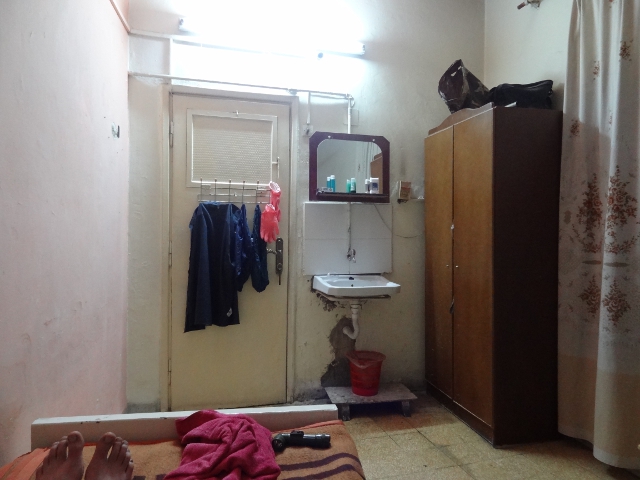
Oh yeh, it even had someone else’s clothes in the wardrobe!
Tomorrow I go to Petra. probably by Taxi via a lot of places (it wouldn’t cost much less to get one just to Bethany and Mount Nebo, so it kind of makes sense!). This sounds expensive. Maybe it is. But most people’s night in a hotel on holiday would be more than the taxi fare plus my hotel, so … swings and balances!
Day 06: Thursday 21 February –
Highs, L’eaus, and even Lowers
“Let me tell you something that we Israelis have against Moses. He took us 40 years through the desert in order to bring us to the one spot in the Middle East that has no oil!”
Golda Meir, Israeli Prime Minister in the 1970s.
Today I learned something. That the Internet is a liar, and that Jordan is actually three hours ahead of UK time.
I discovered this when someone knocked on the door of my room at 4.45am UK time, wondering where I was and whether or not I was up yet. The chap who drove me from Jerash to Amman, I arranged for him to take me to Petra. Now, you might be wondering at the expense of this, but … the price he quoted for the trip, including stops at Mount Nebo and Bethany-beyond-the-Jordan, was 65 Dinar. A price I was quoted in Amman just for the two nearby sites was 40 Dinar; this means I’d only effectively be paying 20 Dinar more for a taxi to Petra than three buses (there is a direct bus but I’d have had time to kill, so …). And besides, that hotel night was only 8 Dinar. Most people of course would spend more money on the hotel than the transport, but then most people have more self-respect than to stay in a dodgy-looking backpacker hostel. Oh, did I mention the bed was too small for me too! Though to be fair, that’s not a big issue given my height!
Today has been mostly about pretty scenery. Now, from far-away Britain, Jordan has always given me the impression of being mostly a flat, lifeless desert, with the occasional settlement along the banks of the Dead Sea. Some of this may well be true – I haven’t ventured that far away from the Dead Sea/Jordan Valley area, however one thing I can say quite categorically is that it is not flat. I had this impression slapped out of me not long after arriving yesterday, and today has somewhat confirmed it. The view from the mountains overlooking the Dead Sea, however, has indicated that Southern Israel is flat and lifeless. Moses again takes some flak for that choice.

The last thing Moses saw before his demise. Was it worth it for the view?! :p
Oh, let’s do the Moses thing now, then. While not exactly at dawn, Mount Nebo was always going to have to be a morning thing, if only because it looks West and it would be pretty pointless to go up a mountain and look straight at the sun. And it’s barely climbing a mountain, not because it isn’t high (it is) but because the road goes almost to the summit anyway so the walk just takes you to the edge.
The view over the upper Jordan Valley over Central Israel is quite stunning though. Or would be if there was anything in Israel worth looking *at*. In the distance it’s possible to see the Mount of Olives (Israel isn’t terribly wide either – you could drive a tank across it in a couple of hours. The same is equally true however of Lebanon – as the Israelis can confirm!), but much of the West Bank is barren hills and scrubland. It’s hard to judge what Moses would have thought; on the one hand he might have looked out and gone ‘this is it??’, but equally, given that he was destined to die on the mountain and never enter the Holy Land (which, before he walked up, he might have felt a bit peeved at, having trekked this far only to be denied. I know how he felt a few days ago at Armageddon …), he might have thought ‘Ha, if they’ve got any complaints, I don’t have to handle them!’. That said, he was probably still smarting from the encounter with the burning bush.
And actually, on that note, a couple of months ago I came across a website that talked about the whole ‘burning bush’ incident, and how they started off deriding one of the strong theories that the visions were caused by hallucinogens in the local plantlife that the Israelites had been dining on. They claimed that idea for the visions was stupid. This is because the visions were actually caused by aliens. I love ‘ancient astronaut’ theories, because everyone likes a good comedy from time to time.
Like all good stories, we now go forward in time, over a thousand years to a small secluded area by a spring on the edge of the River Jordan. Here, we find a man called John immersing a small baby boy in some water, whilst his parents watch on.
Except that, two thousand years later, the River Jordan has shrunk, the spring gone, replaced by a large puddle of brown stagnant water, and the surroundings are littered with stone ruins that formed the foundations of at least 5 churches. This, a few footpaths through the woods, and a large number of Jordanian soldiers in the surrounding desert, is what makes up the ‘Baptism Site of Jesus Christ’, on the very edge of Jordan itself.
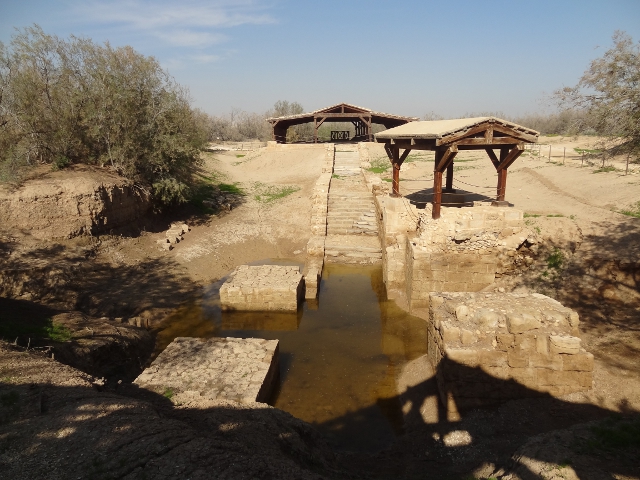
This is the spot. Allegedly. No, I’m not terribly impressed either!
It’s quite a strange set-up. You get a free audio-guide with your ticket, but when I was there we had a real-life tour guide making the audio guide a little irrelevant. The tour is partly by minibus, which takes you from the entrance about a mile to a couple of new churches, where you stop and look around, then on again to the main walkways, before picking you up and taking you back to the main entrance. Not sure if this is because the site is so large, or because of military sensibilities (we even passed a military checkpoint *within* the complex).
It is mainly churches, both ruined ones, and newly-built ones, although I’m a little confused as to who would use them for worship given there isn’t a town in Bethany (well, there is, but it’s in Israel). But there are several new churches having been built over the last 15 years, of several different Christian denominations (although Eastern Orthodox and Coptic are quite well represented). And the pathways around them and to the River Jordan are pretty.
The River Jordan itself … well as indicated above, the actual assumed baptism site is nothing terribly special now, although the historical ruins are legion, if not terribly detailed. The site itself was only re-discovered in the last 20 years, following a rapprochement between Israel and Jordan – previously, this side of the river had been no-man’s land. Further on from the actual site, the footpath led down to the River itself, where it was possible to touch the water. If you’d wanted to that is – it was a bit brown and murky. It’s even possible to arrange to have personal baptisms in the river, but, yeh … that said I doubt the Ganges is any cleaner. Also, on the opposite side of the river, we did see a woman filling up a plastic bottle with the stuff.
Ah yes. Peace and love and harmony and we are all the same. Directly opposite the river from where the footpath ends is a tourist complex devoted to exactly the same thing – the Baptismal Site of Jesus. Except that *this* one is in Israel. The Jordan River forms the boundary of the two countries, and at this spot, on either side of the river, there are places where identically-formed tour parties can do exactly the same things at the same time. The river can’t be any more than 7-8 metres wide at this point, so you can even hear the other side talking. While we were there, Israel seemed to be being visited by a group of Germans … it just felt rather surreal to be so close to something so similar, and yet with a massive cultural and political divide between us.
10 miles from the Baptism site, another sort of religion has taken hold; that of money tourism. All along the Northern part of the East Bank of the Dead Sea are 4 and 5 star hotels, with spas, swimming pools, restaurants, etc, all designed to serve the tourists who see Jordan starting and ending at beach resorts. But not just any old beach resort, no, because the Dead Sea isn’t just any old sea. It is in fact a *very* old sea, with the well-known fact of being so full of salt and minerals that a) nothing much lives in it (Dead, see!), and b) organic beings comprising mostly of water can float in it. I’m not that cheesy, and I also don’t much like doing things in seas, so we drove right past.
One interesting aspect of the Dead Sea area though as well is its altitude – it’s negative. At some point near a bridge over a small dried-up stream, we did in fact pass the lowest point on land on the whole Earth, some 400metres below sea level. Or average (mean) sea level at least – obviously we were just above sea level of the Dead Sea. See! (Oh wait, I’ve already made that pun …).
Mount Nebo is very close to the Dead Sea. Since the sea is below sea level, you can infer that the roads are pretty steep. You may also infer that the roads are also very winding. And you’d be right on both counts. But what makes the routes very special are what the scenery they run though looks like. Stoney, barren, and eerily extra-terrestrial, that’s what. It would be easy to imagine that this was the sort of terrain that the Mars Rover is exploring, or that some of the Moon landings were at. It would actually be quite easy to fake some footage here and make it seem realistic … did someone say ‘Arizona’?
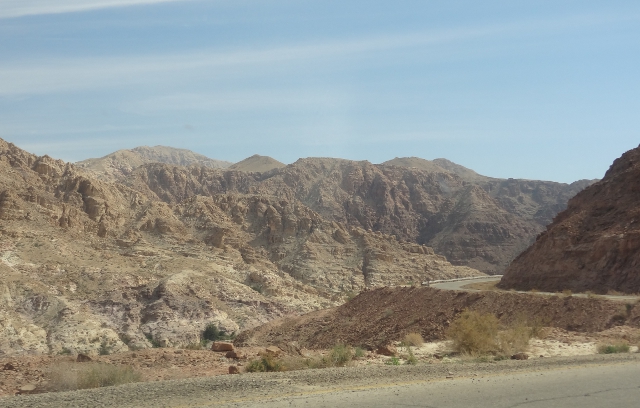
It was like this for about 30km. Twice!
The only other stop we made en route was one pretty close to Petra actually – an old ruined fortification at Shobak. This is set about a mile off the main road from Amman to Petra, but even so it’s still very remote and scenic. It was believed to have been used in the same way as the castle at Ajloun (a similar one also exists at nearby Karak), as a defence against marauding Crusaders, but also served as a centrepoint for the local small town until the rivers dried up and the people moved a mile down the hills to where the town is now. It was a very peaceful location, with views into the hills, and the guard keeps a list of visitors who pass through and only about six people (foreigners) had been there all week. There was no guide and no fence, meaning we were free to wander over the whole thing, and fall off the cliffs if we’d felt so inclined. The nearest I got was coming out of one of the remaining rooms and banging my head on the lintel because of course 12th century Arabs aren’t as tall as 20th century Brits …
Wadi Musa, the town that serves Petra, is a very odd place. It’s essentially one very long road that winds down a hill, leading to a small central area of shops. Pretty much every business here is either a hotel, a restaurant, or, bizarrely, a barbers, Swap Hotel for Estate Agents and it pretty much describes the town I live in back home! There’s not a heck of a lot to actually *see* or do here, and the food’s a little overpriced, but I guess it does solely exist for the tourist market. A bit like the Dead Sea hotels, but much cheaper – this is Skegness compared with their Dubai.
My hotel’s nice though; run by a married couple (she’s a Brit, he’s a Jordanian), and, hey, laundry! This is useful as I left my scrubbing brush in Amman! It’s one of the more expensive rooms I’ve been in, but I did choose a single room for Petra specifically (I’m here for two nights and planning to be up early for both; plus this is one of the stops I’d intended to do my handwashing of clothes). I even have a TV, which I’ve unplugged so I can charge my electrical items.
I’m having issues with this in Jordan actually – as a country they seem to use a non-standard plug. It’s a narrow 2-pin plug, whilst most of the rest of the known world who use two-pin plugs use a wide one. My ‘universal adaptors’ don’t fit in the sockets … fortunately nor do some of theirs; the electric heater has an adaptor on it, which I’m nicking for the duration!
Day 07: Friday 22 February –
Planet Leesti and the Last Crusade
“Look at this. It’s worthless – ten dollars from a vendor in the street. But I take it, I bury it in the sand for a thousand years, it becomes priceless.”
From ‘Raiders of the Lost Ark’.
My feet are incredibly hard and dried out. They were pretty bad before but now they’re an unfeeling mass of rock.
Today I walked around the ancient Nabataean city of Petra, founded some time before 200BC, and served as the capital of the small empire of desert traders (as well as the subsequent Roman Province of Arabia Petraea) – in quite some planning and detail, in fact, as they manipulated local rivers to serve their needs. It’s a huuuuuge area, hidden away in a valley in the middle of the desert, so it’s pretty well preserved. It was abandoned in the early part of the first millennium AD, through a combination of changing trade routes, more important cities, but mainly earthquakes. Interestingly, some Bedouin still live in the complex itself, in caves hewn into the rock.
Petra’s pretty much the main draw for people coming to Jordan; it’s not unknown for travellers to land at Amman airport and immediately whisk themselves south so they can see Petra as soon as they possibly can. And it is quite a way South too – it’s (relatively speaking) not far from the Saudi Arabia border, and the nearest major population centre of any significance is the beach and port resort of Aqaba (which is nestled in that weird angular area at the tip of a branch of the Red Sea where Egypt, Israel, Jordan, and Saudi all lie within maybe 30 miles of each other). Therefore it’s also popular with day-trippers from Israel.
It costs 50 Dinar to get in for one day, 55 for two days, and 60 for three or more. Day-trippers (ie those not spending a night in Jordan) get to pay 90 Dinar. Presumably day-trippers pay more because they’re not seen as otherwise contributing to the local economy by not staying over, by not eating in Wadi Musa, etc. What’s also noticeable is the number of people who arrive into Petra around 2-3pm. Given that in Winter it closes at 4, one hopes that these late arrivals aren’t day-trippers … 🙂
I woke pretty early, grabbed a very light breakfast (some pitta and a spot of hummus), picked up the packed lunch that my hotel made for me (!), and headed out. The sun had risen by the time I left the hotel (it was about 7.45am by the time I got to Petra’s entrance, only some 10min walk from the hotel. I’m glad I chose that hotel and not one of the ones a mile further up the hill!), but even so when I got there, it was quite quiet. I did pass three tour parties on my way down the famous Siq entrance valley, but that was about it for tourists for maybe the next 4-5 hours!
Now, you might be surprised to note that most of my walk through one of the most famous historical sites in the world wasn’t spoiled by tourists. This is for a number of reasons: although it’s Friday (and therefore the weekend in Jordan), most people wouldn’t have arrived till later anyway; it’s February and therefore still pretty much out of season (they had to evacuate the site a couple of weeks ago due to flash flooding caused by melting snow!); but mainly because I ended up walking along obscure trails (I won’t say paths, cos they weren’t) along the edge of the site rather than in amongst the main routes. This was partly through intention – one of the first things I did was walk up a long, long, LONG, flight of stone steps that twisted their way up one of the many mountains that line the site, to a place called the ‘Hill of Sacrifice’, which, as the name suggests, is where ritualistic practices were made (mostly animal!) – but partly also because when I got to the top, I bumped into two backpacking Americans (Mark and Matt, one of whom lives and works in Jordan, I think that was Mark, let’s assume so for the rest of this entry!) who were also exploring, and offered to let me tag along with them.
Mark comes to Petra quite often, so knows many of the backtrails. He also knows many of the Bedouin hawkers who peddle their wares on the paths. What was odd was the way that even on some of the really obscure paths that we went on, we did occasionally find Bedouins selling stuff! We stopped off for a couple of teas along the way, including a ‘sage tea’, which was quite nice, more ‘earthy’ than mint tea.
Some of the trails we went up (and down!) were steep areas of rock where no path could be clearly defined; one trail late on was up a route to a spring that even Mark didn’t know about, but one of the Bedouin sales girls he knew directed him to (including giving us directions from far below by pointing when we weren’t sure where we were going)! It certainly felt at times that we had the whole place to ourselves; some people say Petra deserves two days and I think if you did the sort of thing we did, that’s probably true (we walked pretty quick!). So many people just walk in (or even ride the donkeys), see the “monastery” remains, then go out again, which seems like a waste of a day and 50/90 Dinar to me!
There’s not really that much else to say about my day – lots of walking, now have a plaster on the top of my foot where sand and fine gravel had been rubbing between my skin and the strap of my sandal. Hope that doesn’t cause me too much gip tomorrow when I explore the desert! Am knackered too – hopefully will sleep well tonight (though I will be awake at 5.30am to make sure I catch the bus to Wadi Rum in time!). Also hope I don’t cramp up too much – in the bar (!) of the American’s hotel (which was about 4 buildings away from Petra’s entrance – and I thought *I* was close!) I did feel my thigh muscles going once or twice. Meh.
Guess you want to see some pictures now! :p Here they are below!

Arizona, again … !!
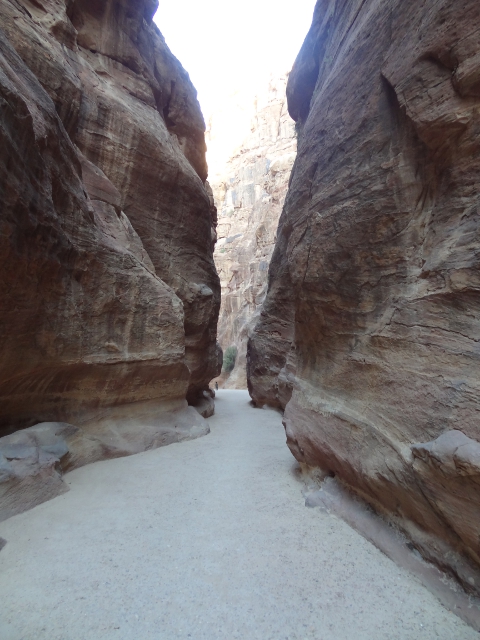
The Siq – entrance to Petra. It used to be a river valley.
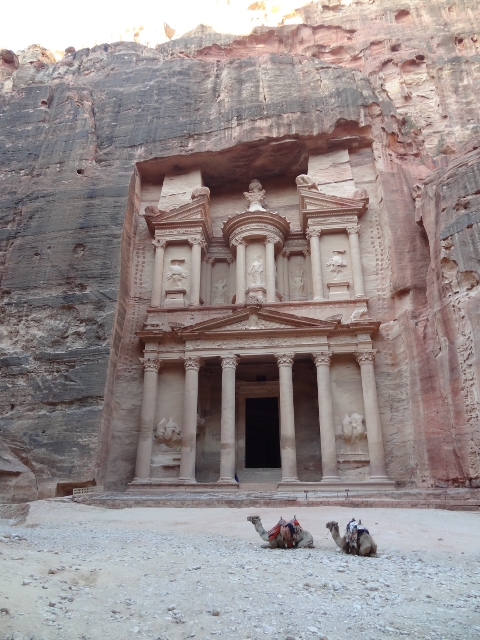
The Treasury; at some point in the past people have taken pot-shots at it with guns because they thought it still contained money!

The tomb of Unayshu, and others, taken from the steps to the Place of High Sacrifice.
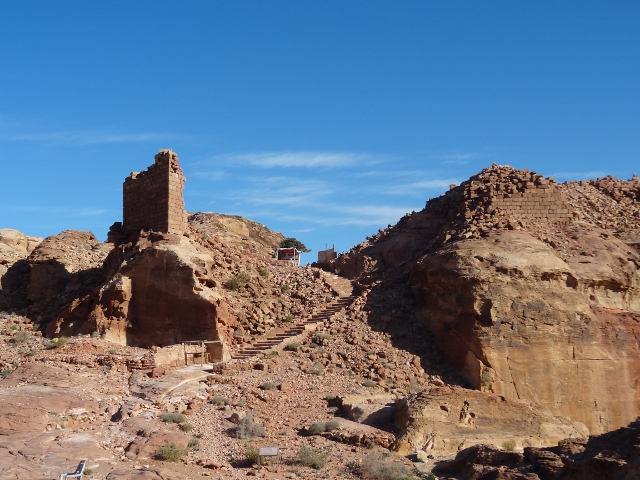
Somewhere near the Place of High Sacrifice.
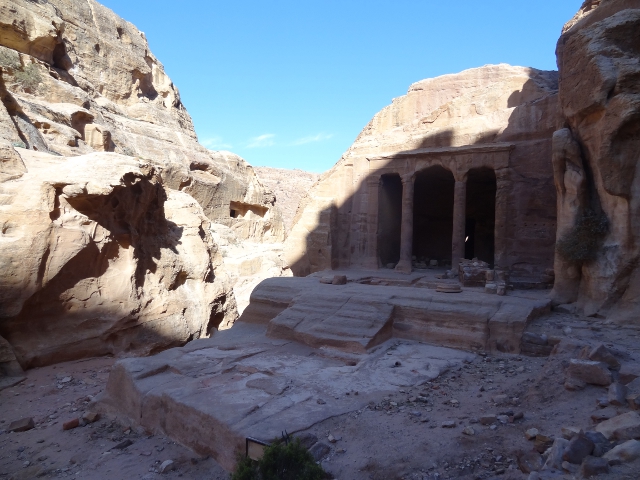
The Garden Triclinium – there used to be a garden in front, apparently!

One of the many examples of a structure surrounding a small cave.
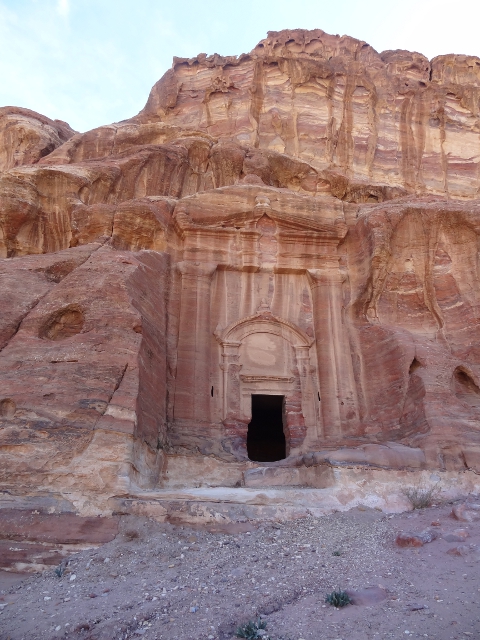
Another example of a cave surround – note the rock colours.

On the Al-Habees hill, overlooking what I assume is Qasr Al-Bint.
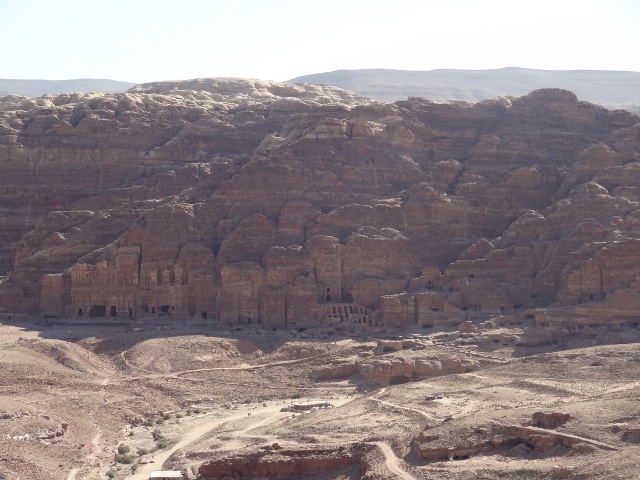
Petra was often far below us on this hike …
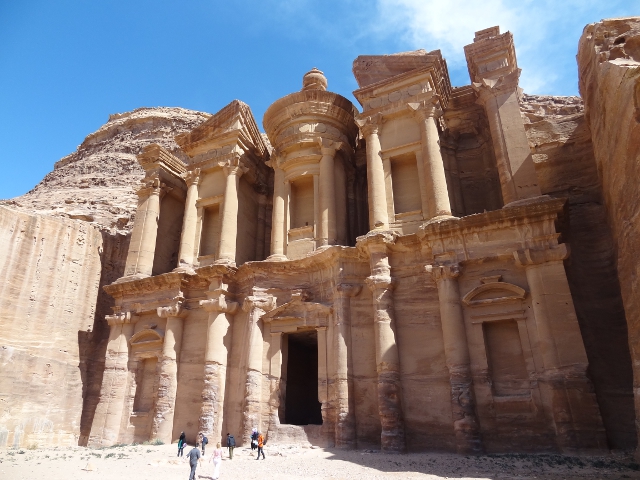
The “Monastery” – the furthest point from the entrance most people go.

It really is quite a spectacular place!
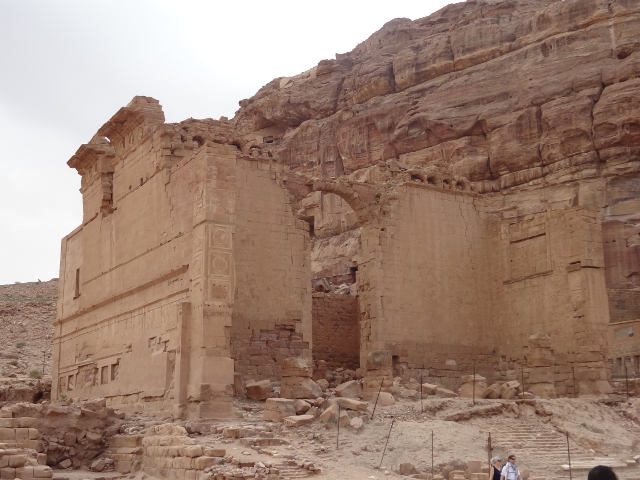
We think this was a tomb, but could have been a church – there were lots of both!
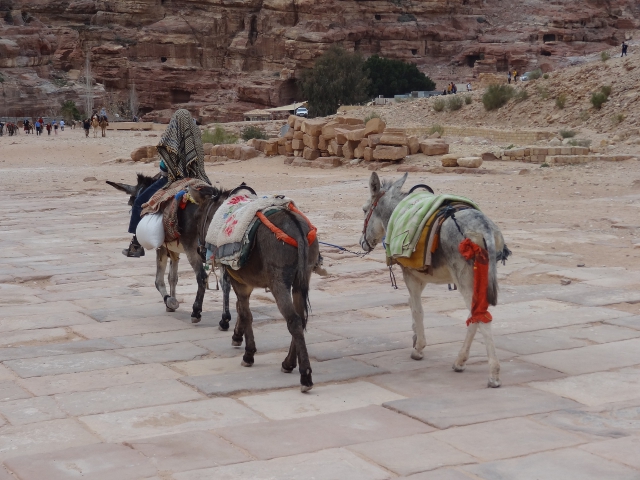
A ‘Petra Taxi’ – complete with aircon and sunroof. And you could even smoke in it!
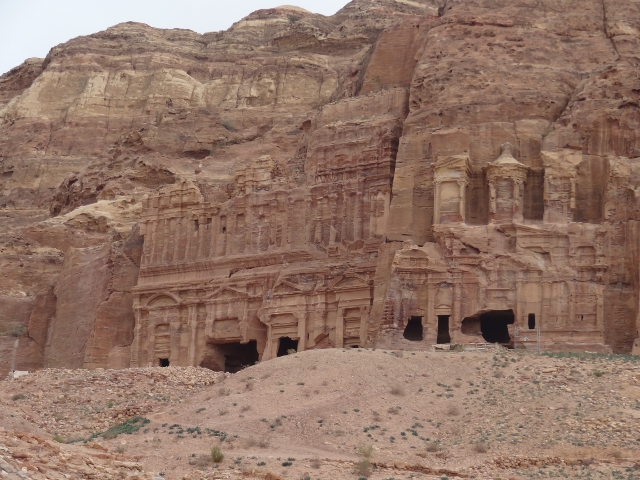
Part of the ‘East Cliff’, mainly tombs.

Another section of the ‘East Cliff’, again mainly tombs.
Day 08: Saturday 23 February –
Aux pieds nus dans la poussiere et les sables sauvages
“I’ve never tried crossing a desert before, but by Toutatis I’m ready to tackle it”
Asterix, in ‘Asterix and the Black Gold’.

View from the campsite.
You’d have thought that sandals, trekking sandals, the clue’s in the name folks, would have been useful things to go trekking through sand in. Well, you’d be wrong.
Today was further proof too that when I speak in French, it’s very amusing to nearby French people, and they tend to respond in English, possibly out of pity, I’m not sure … :p
The plan today was always going to be to take a wander through the southern Jordanian Desert at an area called ‘Wadi Rum’. It’s between Petra and Aqaba, and is a natural wilderness protected area by the government – it’s pretty much world famous as being a good place to go hiking for days on end, take jeep tours around the local environment, ride camels (if you’re so inclined), and spend the night at a Bedouin camp under the stars. All the guides are locals (many have entire families that work in the tourist trade – and some Bedouin families are pretty big!); on the one hand you might consider it a ‘closed shop’ where prices are inflated to grab the tourist dollar, but on the other, you’re getting taken around an area by the people who genuinely live there; regardless of their motives they do kinda know what they’re doing and where they’re going!
One of the problems with them though is that they offer tours based on the number of people in a ‘group’. This means that solo travellers are slightly discriminated against as they tend to end up on tours ‘on their own’, which pushes up the price. Also, some guides and ‘companies’ don’t really offer anything for solo travellers because of the hassle that this would then cause.
I was therefore feeling a trifle apprehensive on the way there as I hadn’t been able to get anything organised, so would have to see what would happen when I got there. Solo tours could cost me anywhere north of 55 Dinar (and roughly that’s £55), and I really didn’t want to be on my own anyway, as I think I’d have felt a bit awkward about that.
Fortunately, by default, and slightly by accident, four of us ended up in the same boat and formed an impromptu group. One of them, a French lady called Valerie, I’d bumped into the previous night at the hostel, and she was undecided between Wadi Rum and Jerash (after seeing my pictures of Jerash she said’ that’s really beautiful but I’ve just spent a day in Petra’!). On the bus from the hotels to Wadi Rum, she got chatting to two other Francophones (Julien and his partner Nancy), who it turns out had nothing planned either. So when we all got dropped off at the Wadi Rum visitor centre, after everyone else on the bus had confirmed they were in a tour already, we kind of … joined! Valerie had also got the number of a particular guide (Souleyman) who’d been recommended by ‘some French guy on the bus’, so a phone call and a quick negotiation got the price with him down to 30Dr each.
Here, let us pause for a second to consider this. We were being offered a 3.5 hour jeep tour around many of the desert sights, an evening meal, and overnight accommodation in a tent, for the equivalent of £30 each. I’ll let you consider if that’s cheap or not … !!
First we headed to his house, which mainly seemed to consist of a very long living/dining area. He had ‘all mod-cons’; we even used his Wi-Fi access :p. Before lunch he took us just outside the village to the bottom of a rocky hill, which we climbed to visit the site of a small spring. Quite unimpressive spring, in all honesty, but the views were good. Although not as good as the views to come later!
Lunch was a mix of vegetables, tuna, aubergine-made-into-hummus-like-consistency (which gave rise to an odd question from Nancy – what was the English word for Aubergine? She didn’t know that’s what we called it, and thought she knew another word which escaped her. Unless there’s some American slang term for it I don’t know about, I’ve always presumed that it was only ever called Aubergine; they’re not native to the UK so we wouldn’t have created our own word for them), and tuna (oddly).
[This is rapidly becoming in danger of being a mere ‘we did this, we went there’ day, so let’s change that!]
The desert is much as you’d expect. The guide (Souleyman has six brothers, so there’s a lot of people to look after many groups!) drove us in a well-used but still fully-functional 4×4 – this is real off-road territory, so he’s forgiven. Indeed the ‘roads’ are merely the tracks laid in the sand and gravel by endless previous trips out into the desert!
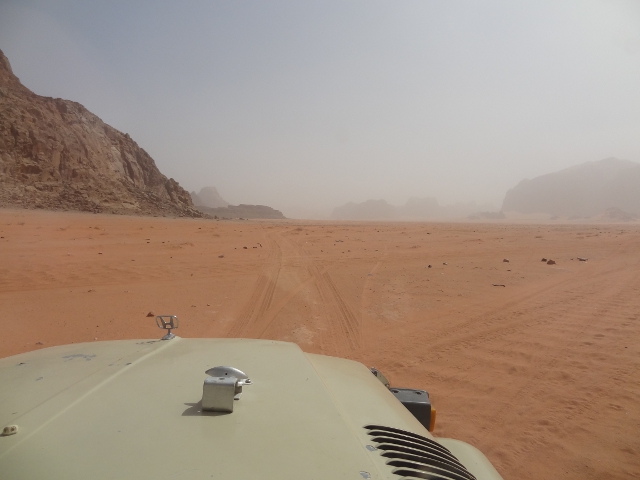
Roads? Where we’re going, we don’t need roads!
It’s mostly sand, but in many parts it’s been compacted down so it’s quite hard. In addition, it’s quite stony ground in places. It’s not flat though; aside from the endless undulations that made the trips quite jerky, there were quite a few hills and plenty of large rocks, like ‘hill-sized’ rocks! Some of which are actually climbable …
The area is very much ‘Lawrence of Arabia’ territory, and many of the landmarks visited were used in the film of the same name. Which I’ve obviously never seen, don’t be stupid. 🙂 One of them, the so called ‘Lawrence House’ is actually an old Nabataean structure (as per Petra, yes!) that’s now quite ruinous. The Nabataeans actually had a fairly reasonably-sized ’empire’ that stretched southwards into the heart of what is now Saudi Arabia (there’s a smaller version of Petra just over the border, but obviously much more difficult to get to!).
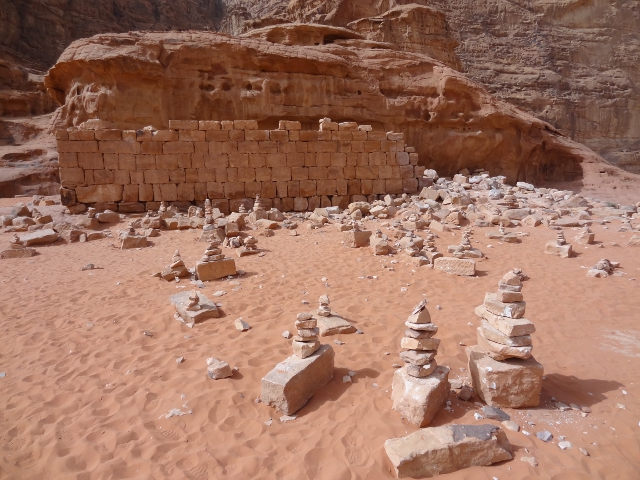
Nabataean House. Weird rocky things at the front – old gnomes? lol.
I’m not aware, however, of Lawrence of Arabia having to run up a sand dune chasing a French woman and a Belgian man. The views from the very top of it were very impressive, however the effort of getting there darned near killed me. What I have also learned today is that I’m not as fit as I used to be … :p

View from the top of said sandhill. Dead Englishman not pictured.
This also meant that I didn’t scramble up a fairly steep, smooth, rock face to stand on the top of a small rocky arch elsewhere in the desert. In this case it wasn’t that the going up would have killed me, it was more the going down I was concerned about. Julien and Nancy merely strode up it as if it were flat.
To be fair, he’s a skydiver and she’s a dancer. Even Valerie works in tourism and used to work on cruise chips. With my job, I felt almost ‘boring’ lol!
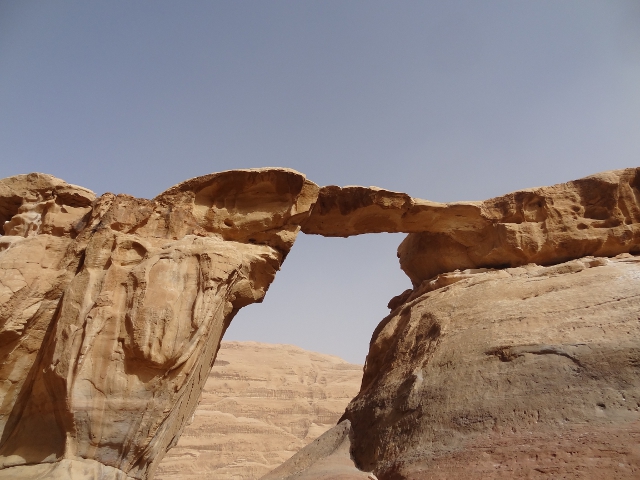
The arch. Buggered if I was climbing up that!
We reached the ‘camp’ around 4pm-ish; it consisted of about 6 tents, each with two beds in. These tents were on stilts above the ground (so that the wind can blow straight underneath them) and were actually quite warm and cosy inside. A few meters away was the big open tent where we’d socialise, eat food, and have the campfire, and just further on was the toilet block and the guide’s tents.
Now, I say ‘tent’ as that’s probably the right word for them. However these were not the sort of tents you’d put up on a camping trip – these were bigger heavy-duty things, actually similar to beach-huts but bigger. They weren’t full-on yurts though – they were big enough for a couple of people but no more than that. And they were a nice barcode-type pattern of black and white. Shame about the ‘interesting’ pillows (Barbie? Tom and Jerry?
Food was a kind of pasta soup, followed by chicken/rice/vegetable mix. Obviously there was pitta bread too! And after soup came chatting, a couple of party-type games, and a few singsongs, all mixed in with large amounts of “Bedouin Whisky” (tea to you and me, served black, sweet, and flavoured with herbs like sage, cardamom, or mint), although the guides headed off to bed around 9pm-ish (they tend to get up early in the mornings!). We headed off not long after, but I stayed up to write a letter and to look at the stars.

Our campsite! See how remote and small it is?
Ah yes, the stars. Obviously it’s the middle of the desert, so there’s no light pollution. In fact there’s no pollution of any kind, except dust, and the occasional dodgy exhaust from the 4x4s! When I was in the tent, the only sound I could hear was the rustling of the wind against the sides – there’s not even a distant hum of traffic that’s present virtually everywhere in England. And so of course the stars were legion in the sky – it’s actually hard to imagine how the ancient astronomers could define the constellations as there are so many stars in the way of the bigger stars! It’s just a shame it was a bit too cold and breezy to stay out there for too long (I didn’t pack for colder weather, just a lightweight fleece and that’s all!).
So, early night (which is just as well as another early start in the morning). Julien and Nancy are staying for an extra day, when they’ll do more jeep tours, or possibly a camel ride; Valerie wasn’t sure what she was doing (she has a flight from Tel Aviv on Wednesday morning) but has decided to go at least to Aqaba rather than stay with them, so there’ll be at least two of us on that stupidly early bus!
Day 09: Sunday 24 February –
One does not simply walk into Israel
… This is because you can’t – the roads in Jordan have no pavements and end in checkpoints. However you can walk from the border control into Israel. We did. Although we were directed down a ‘short cut’ (avoiding the highway), it turned into what amounted to a farm track next to some construction works and only eventually hit the main Eastern hotel roads, still quite a way outside the town centre. In the oppressive morning heat, my travelling companion opted for the bus the rest of the way.
But first, Jordan.
We didn’t end up having breakfast at the guide’s house, as had been suggested, because the only daily bus to Aqaba was due to leave around 6.20am so the guide picked us up and took us straight there. Interestingly, despite being the only daily bus, me and Valerie were the only non-locals on it – after going round the village it was packed to the rafters with Bedouin. Wadi Rum village is presumably not that big so we probably could have picked the bus up from anywhere, but we were amongst the first on and we got decent seats. I assume that the other backpacker tourists all got shared taxis instead. Us = cheapskates.
Aqaba’s … functional, as a town. We only passed through it to grab breakfast (mint tea and baklava), and so we could both send stuff off, then we caught a taxi to the border (after some Valerie-skilled negotiations). Evidently it’s off-season, even this far South, so bargaining power was in our favour. The lack of tourists was further shown at the border, where we were amongst the very few to pass into Israel. We did notice quite a lot of groups going the other way – one assumes these are day-trippers from Eilat to Petra.
Getting across the border itself was pretty easy and swift – none of the angsty questioning I’d been expecting. They did want to examine the contents of my backpack in great detail, but two passes through the x-ray machine (one with dirty clothes and books, one without) and I was happily on my way.
I did realise later that I’d completely forgotten about the world’s biggest freestanding flagpole, which is supposed to be around here somewhere. Quite why the world’s biggest freestanding flagpole is in Jordan is something I’ve no clue upon. Maybe it’s a hangover from the days when they didn’t really like Israel that much.
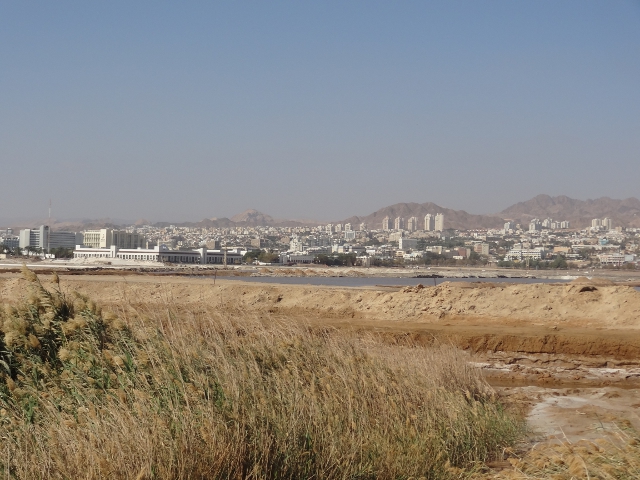
Eilat city centre from the ‘short cut’.
Eilat … it’s a bit like Blackpool. It’s a cheesy, popular, beach resort with big hotels and tat for sale at beachfront stalls. However it doesn’t seem to have an equivalent to the Pleasure Beach theme park, and nor does it have a terribly good beach. Most of the central section (ie that bit which isn’t linked to beachfront hotels) is a pretty narrow strip of gravel-covered sand (so not even a proper beach either!). Conversely, Eilat airport is right in the centre of town, and when planes come in to land it feels almost at though they’re using the main hotel road south as a potential emergency runway!
The other dis-similarity is that at midday, the temperature was a triflingly warm 26 degrees C. My research on weather had suggested that although Eilat never got cold, and that it was always going to be the warmest place en route, February was still Winter and therefore I’d be expecting a reasonable 20-21 C. I didn’t pack sunscreen. This means that although I wouldn’t look ‘blue’ as I did in Laos, I would probably go ‘a bit red’. And there didn’t seem to be terribly much shade anywhere.
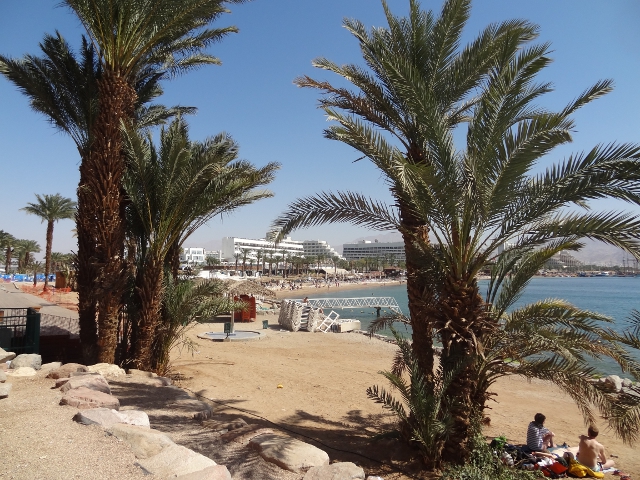
Eilat beachfront. Snore.
I was only there for so long because the next bus to Jerusalem was at 2.15pm and we’d got there just after 10am. I could of course had got a bus to Tel Aviv and a connection there to Jerusalem but that would have been too logical. Besides, this meant I could spend 4 hours looking around town and seeing what there was.
I got to the bus station an hour early. Because I was bored.
Ye (not olde) trip to Jerusalem took around 4 hours and ran up the other side of the Dead Sea, which meant mostly the same old scenery: flat dusty gravelly sand, distant rocks, and a flat body of water. Maybe it would have been prettier had it been the first time I’d seen it, but it wasn’t so therefore it wasn’t. Meh. The bus took this route rather than going through the central Negev – this meant we passed through the West Bank, but being on an official Israeli Bus (from the ‘Egged’ company) there are no issues with this.
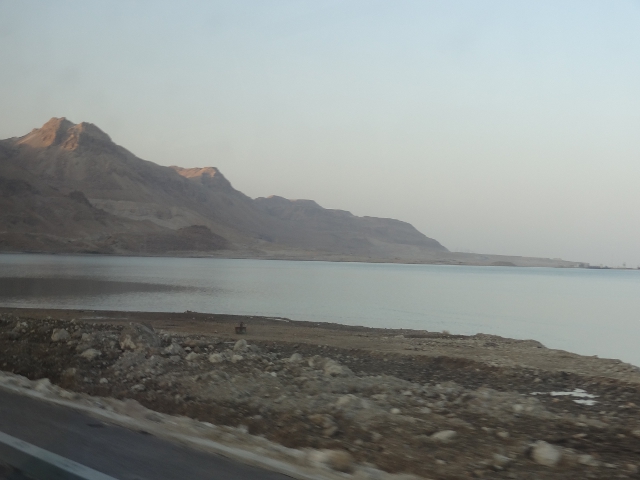
The Dead Sea, somewhere in the West Bank.
On leaving the bus station in Jerusalem we were subjected to more security scanners, before heading off into the city. The directions to the hostel made it sound quite an easy walk, but I have to say it felt like I was walking through somewhere quite ‘dodgy’; I’m sure they were prostitutes, beggars, and drug dealers hanging around outside some of the closed shop doorways (well, some random woman covered in make-up tried to talk to me but I just strode off; I assume she was a prostitute!), and I have to say for the first time on my trip I didn’t feel entirely safe.
Had trouble finding the hostel itself (it was slightly round a corner) but got there in the end. It’s huge; much bigger than anything I’d stayed in before (with the possible exception of a hostel in London King’s Cross that used to be an old prison and is themed accordingly). Interestingly though, my recently-found self-confidence is such that big hostels no longer induce the fear in me that they used to. Doesn’t mean I’m going to talk to anyone, of course, but it does mean I will at least give myself the option.
Sharing a 4-bed dorm with three other guys; not really met them yet but we were all in bed by just past 11pm, so I get the impression they’re not Party Animals!
Oh, speaking of Party Party, today is ‘Purim’, a Jewish festival that seems to cause everyone to dress up in stupid and jolly clothes. Lots of the children in Eilat were in costumes (eg superman, Alice in Wonderland, a pirate), and many of the waiters/waitresses in restaurants/cafes I passed both there and in Jerusalem were wearing silly headbands with things on them. There were also lots of people dressed up with masks and face paints, and many of the cars in the streets in the evening were beeping their horns. There were also fireworks until late into the nigh which I, er, seem to have slept through! 😀
Day 10: Monday 25 February –
I see General Pinochet’s dropped to sixth …
Ahhhh chocolate! There’s nothing that a good breakfast won’t solve and, after a reasonably good sleep interrupted with having to blow my nose a lot, some thick bread smothered in chocolate spread worked wonders to my health. One thing I notice about travelling is that I tend to eat less than I normally would on a given day – it’s often lunch I skip.
On a related note, also when I’m travelling, time seems to go slower in retrospect. That is to say, exactly a week ago I was failing to get to Tel Megiddo. It feels like much longer.
What we can conclude from that is that the average office job is, in fact, inherently dull, meeting the same people every day, being in the same place, using the same systems, and in fact the office environment is also conducive to getting fat as your mind encourages you to eat more to relieve the mundanity.
* waves to the folks at work reading this. Assuming you are reading this. But you know all this anyway. Maybe you feel the same. Maybe that’s why you take cigarette breaks every couple of hours. I’m sure it’s the same the world over, and, surprisingly, regardless of the previous sentence, I do genuinely like my job. But them I’m a geek. 🙂
Anyway, genocide.
So I’m in the Jewish Homeland. It makes sense to visit the Yad Vashem Holocaust Museum. Interestingly, it didn’t have any bag searches or security checks; one assumes the assumption here is that even “they” wouldn’t choose to cause trouble here?
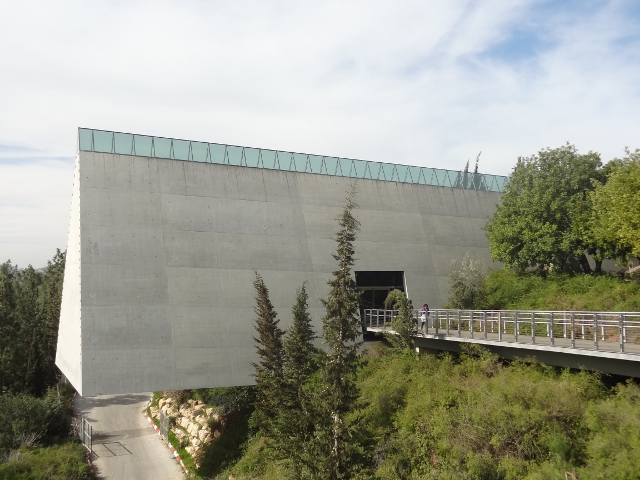
The Holocaust Museum – at odds with the natural environment just as the concept is at odds with the natural world.
It’s an absolutely huge place – I went round the whole thing in about 3 and a half hours, and even I was ‘rushing it’ towards the end. It’s in a weird building – a ‘wedge’ of concrete built into the side of the hill. Apparently this is on purpose; it’s symbolic of how the Holocaust caused a big unnatural ‘rip’ in the world. The museum effectively takes you on a timeline of antisemitism (*), starting all the way back with the origins of it when Christians accused Jews of ‘deicide’ by murdering Jesus, through the stereotype of the moneylender (a profession forced upon Jews in the early middle-ages when they were banned from holding regular jobs, whilst the (Catholic) Church forbade Christians to handle money), all the way to the specific origins, effects, and aftermath of the Holocaust under the Nazi regime.
Having studied the rise of the Nazi regime in ‘A’-level history, to great depth, most of what was in the museum I already know a fair deal about anyway, but it was interesting to remind myself of it and see it from a slightly different source. As I’ve said in a previous travel diary, sometimes I feel that people think too much specifically about the Holocaust itself rather than about the whole Nazi terror – Jews amounted to less than half of those the Nazis killed – but obviously in Israel they’re going to concentrate on the fate of the Jews rather than anyone else (and to be fair, the Jews were by far the largest individual grouping to suffer). I still think the Khmer Rouge killed a greater proportion of available people though. Not that we’re ranking genocide, although I’m sure some people would, like a game of Top Trumps: Number of People killed, Proportion of Population Killed, Length of Regime …
I did think of The Killing Fields towards the end though – there was a quote about the Holocaust said not long afterwards that was something along the lines of ‘let this never happen again’. Unfortunately … Cambodia, Rwanda, Srebrenica … people will always hate each other for some random reason. The fact that I would have survived the Nazi regime without too much trouble doesn’t make it right; I wouldn’t have survived Cambodia for instance. Who knows where the next one will be?
[* – As an aside, the word ‘antisemitic’ is quite an odd one, as in everyday parlance it seems to relate purely to Jewry. However, ‘Semitic’ refers to the peoples and the languages of the whole of the Middle-East, not just one specific grouping. It is interesting to note that the most widely spoken Semitic language is, in fact, Arabic, thus in theory any current anti-Arab sentiment occurring in the Western World could be argued to be ‘antisemitic’.]
As a minor point, Britain doesn’t come out of this too well (again!), as of course at the time, Israel was a British Mandate, and we had a policy of not letting anyone emigrate there … in 1948 we pretty much gave up the futile struggle and gave Israel her independence. A day later Israel and the Arabs were at war; the Israelis won and current affairs began!
I reached the other museum at around 2pm. This was the ‘Israel Museum’ – the foremost art and history museum in Israel (I guess the clue’s in the name, really). Although it has a strong focus on Israel and Jewish topics (a whole section on Jewish rites, symbolism, and synagogue designs all over the history of the world, as well as a section on Israeli art), there were also large sections of European art (mainly Impressionists and Surrealists), and sections devoted to archaeology from all over the world.
One of the biggest sections though was on the archaeology of the Holy Land itself, stretching from way back in prehistorical times (cue early humanoid bones and 250,000 year old art) all the way to the Ottoman takeover of the area in the 1500s. They had subsections on local coinage, ancient Hebrew writing, and a few other things too.
The ‘special exhibition’ (requiring separate ticket, although for no additional charge) was devoted to King Herod. yes, that King Herod, 73BC-4BC, who was bezzie mates with Marc Anthony and Cleopatra, but became just as pally with Augustus after his defeat of the former. The exhibition took you through his life, his palaces at Herodian and Jericho, the sort of food/drink he would have had in those times, and his mausoleum. Herodian is a site you can visit, but there’s no public transport there, and it lies an awkward 18km south of Bethlehem, in the heart of the West Bank, so it’s not on my itinerary this trip!
The museum was vast, but my main fault with it was it didn’t seem to be in any kind of coherent structure. Things seemed to be split between levels, there didn’t seem to be any natural route round, and passages led off into different areas on the same theme that gradually turned into something else, which meant if you made a turn you’d end up missing bits. I also got a bit lost twice!
In a separate annexe to the museum is a small display devoted to the Dead Sea Scrolls – some first-century writings that appear to be related to the scriptures and stories that eventually became ‘The Bible’. They were an important discovery as they provide often the only example of some of these stories in this form, or in ancient Hebrew (some survived in Greek translations and were used in the Bible, but were left out of the Torah).
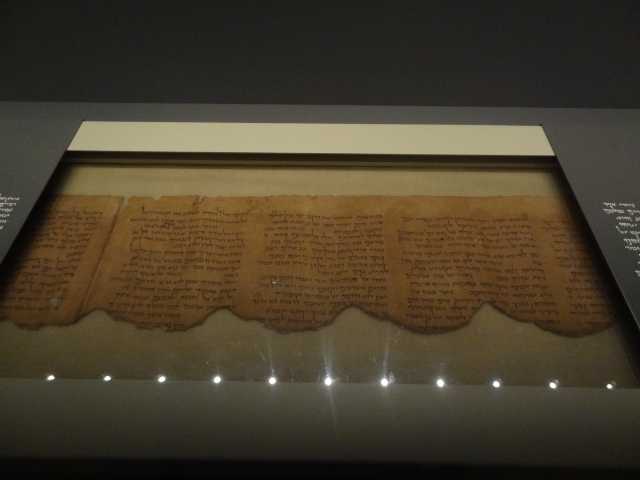
Dead Sea Scroll, fragment. You’re looking at Theological History right there!
By now a) it was about 4pm, and b) I was hungry (fortunately my thirst was quenched by both museums having drinking water fountains. Always helpful!), so I wandered by a restaurant that gave 10% off because I’m staying in a particular backpacker hostel. Heh. Quite nice food too, though I can’t remember what it was. I should have made a note. My main course was something native to Kurdistan, of all places, and involved chicken and rice and vegetable formed into a sort of ‘mound’ (it’s called ‘upside down’ though I’m not sure there’s a ‘right way’ to serve chicken with rice). A bit dry, but that’s chicken, rather than the food itself. I really need to concentrate more on food with more of a ‘feeling’; I guess that’s why I eat so much halloumi at home.
[A recent conversation with an online friend has revealed that it is possible to buy pre-flavoured tofu, and that it doesn’t taste too bad. Not that tofu itself tastes bad, it just … doesn’t taste of anything much really at all. I must do some research on this.]
[And no, I’m not vegetarian. I just cook a lot of vegetarian food, I like going to the vegetarian cafe in Nottingham city centre, and I tend to often take the veggie option in pubs. This is partly why – there tends to be more moisture and flavour in it.]
Apart from this restaurant (called ‘Ima’, and the staff were still wearing the Purim-related headbands with what looked like small feather dusters on them), I have noticed that the people here in Jerusalem don’t really smile that much. And I thought Istanbul was a bit dour!
I also did laundry (as opposed to having it done for me, as it was in Petra) – this involved messing around with small change. I bought my hand-washing stuff to wash clothes with, but to date I’ve only used it once, in Amman. But it’s better that I had it, just in case. I should need to use it once more, probably on Thursday or Friday just to get me through to when I get home. Whenever that will be!
This actually confirms my increase in self-confidence, would you believe, since in the olden days I wouldn’t have gone near somewhere as social as a laundry room, where I might actually have to see someone. I’d have just brought enough clothes …
Day 11: Tuesday 26 February –
Blasphemous Rumours
LISTER: Do you mean they had a war over whether the doughnut diner hats were red or blue?
HOLLY: Yeah. Most of them were killed fighting about that. It’s daft really, innit?
LISTER: You’re not kidding. They were supposed to be green.
Jerusalem in a nutshell, courtesy of Red Dwarf.
Don’t get me wrong; I do really like Hummus, especially the real stuff you get over here. It’s quite different to the packaged stuff back in Blighty – this is soft, smooth, almost runny, compared with the stuff that’s the consistency of chocolate mousse back home. However, after having it for most days in the last week and a half, I fancied a change, so this evening in a restaurant (Babis) in the trendy cafe/bar/restaurant area of Jerusalem just off Jaffa Street, I had a Mexican Salad. Granted I did have an Israeli beer with it (Goldstar), but … 🙂
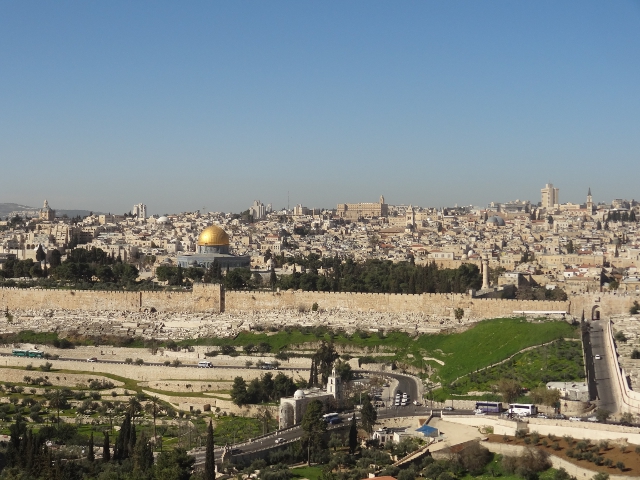
Jerusalem, as seen from the Mount Of Olives. ‘Dome of the Rock’ pictured.
Today has been all about Old Jerusalem, with a soupcon of religion thrown in. Today has also mostly been about walking – the heat’s subsided so it’s only about 23-24 degrees C today, so while I must have looked a complete knob with the fleece tied around my chest whilst still wearing the hood, it presumably served its dual-purpose of a head covering. Given that, last I heard, the UK still had snow, I may have to invoke the German fashion faux-pas of socks-with-sandals upon my return on Sunday. But then I’d rather look a knob than freeze/burn (* delete as appropriate).
Religions today included Judaism, Islam, Greek Orthodox Christianity, Coptic Christianity, several other Christian sects, bur nothing terribly deviant from Abrahamism. Much to my relief, I have yet to see a Buddhist temple at any point en route. And Atheists, in general, don’t have churches. And if they did, they’d probably not find much call for a church here. This is God’s country (and not Yorkshire, as many would also have you believe. Although Sheffield might well be a good place to start a religion. It seems to have in spades one of the features that all religions seem to have; a lot of hills).
Seriously, on that note, what with the Mount of Olives, the hills around Galilee, and Nazareth city, Jesus must have been one heck of a fit dude with a low BMI! Unless he was lazy and caught the donkey taxi everywhere.
Let’s start with Judaism. At the edge of the Old City lies the ‘Western Wall’, which might go down as the world’s oddest synagogue. For a start, it’s in the open air! I managed to find it by accident (going down one of the many narrow paths in the city I encountered a scanner/baggage-check point), so wandered through to have a peek. I didn’t actually go to the wall itself (I could see perfectly well from behind a small fence that divides it from the rest of the city), but I saw everyone praying/milling around at it.

The famous Western Wall. More important spiritually than visually.
In common with many religious sites, there’s actually separate ‘areas’ in front of the wall for men and women – both can mill around happily in the main area but to actually pray, the wall is segregated. It also has two entrances; the main entrance is the other side of the wall area from the way I came in, and in theory even has separate gateways for men and women, although when I passed that area later, it didn’t seem to be an enforced policy.
As a visual site, it’s quite uninspiring. However, it’s effectively all that remains of one of the original Temples Of Jerusalem, and therefore has been a holy site for Jews for coming on to 2,000 years at least. The rest of the temple still exists, in parts, but is bizarrely being used as the ‘foundations’ for the second major site in the city.
Jerusalem used to be Pagan (in the sense that the Romans were Pagan), but no-one seems to talk about that. Certainly though, even during the Roman period, it had a majority Jewish population. However, for much of its existence, Jerusalem has been a very Islamic city. Muslim armies first invaded in the 700s, and apart from a couple of periods of Christian invasion (Crusades, British Protectorate), it was Islamic until very recently. Indeed, the Old City of Jerusalem itself still has a largely Islamic population.
The remains of the Jewish temple is used as the foundations of the Temple Mount (hence its name, one imagines). This is a supremely holy place for Muslims, and covers maybe a fifth of the entire Old City area. Access is heavily restricted (when the area is open at all, it’s only open for brief periods between prayer times, and even then the mosque and shrine at the top are closed to non-Muslims completely, and have been for maybe 10-12 years). Just as at the Western Wall, there are open-air prayer areas at the top – here, however, because the vast numbers of Muslims who come up here to pray far exceeds the capacity of the mosque (Fridays during Ramadan could see a couple of hundred thousand people).
The entrance to the Temple Mount to non-Muslims is through a small gateway just to the side of the main entrance to the Western Wall. It’s also not very well signposted – this is apparently on purpose, to hide the fact that it exists at all. I’d imagine it’s rather hard to hide a very large building at the top of a hill with a golden dome on the top of it, but there we go …

The ‘Dome of the Rock’. Not a mosque, merely a shrine. Albeit an incredibly important one!
And why is Jerusalem so holy to Muslims? It is believed that not only is Jerusalem the site of the ‘furthest mosque’ revealed to Mohammed in a ‘dream’ (indeed the mosque atop the mount is called by that name as a tribute), but also it is the site of Mohammed’s ascent to Heaven (the ‘Dome of the Rock’ being the shrine to commemorate this, believed to sit on the very spot where this occurred).
Cynics might argue that Islam believes this about Jerusalem because they took inspiration from Christianity. It is interesting to note that from the temple Mount, over to the East, on the Mount of Olives, one can see at least two churches that are believed to mark the spot that Jesus, er, ascended to Heaven (because the different Christian sects couldn’t agree on the exact spot!). So, two major world religious figures, both ascending to Heaven, and both doing so within a couple of miles of each other. Coincidence? You decide … And nobody’s even mentioned Mithras yet …
Of course, Christianity was the dominant religion for a few hundred years between the Romans and the Muslims. Indeed, the Temple Mount used to house a Christian religious site, albeit in ruins for much of its existence. Furthermore, when the Crusaders invaded and retook Jerusalem, they merely adopted the mosque and shrine atop the Temple Mount. By putting a cross on them. Yeh. That said, the Muslims did the same to a few Christian churches, by putting minarets and the Mihrab inside them … it’s all a really odd form of recycling!
The most important church in Jerusalem is the Church of the Holy Sepulchre. It lies at the end of a series of passageways that are designated the ‘Via Dolorosa’ – the route by which Jesus went, with cross (there are churches at every single ‘station of the cross’, though not all the churches are the same denominations), to his place of execution – and the church itself is built on the site of his crucifixion – Calvary/Golgotha. There is some dispute about this; after all it is widely assumed that Jesus was crucified on a hill. The church is actually big enough to cover a naturally raised bit of land, and you do have to climb steps within the church to reach ‘the site’, however this would make Golgotha more of a ‘small mound’ than an actual ‘hill’ – the sort of mound, indeed, that you might find in a landscaped park, or leading up to a railway embankment. Compared with, say, the Mount of Olives, Calvary is a doorstep. It also lies deep within the city walls – whereas a remembering of the only Christian Easter hymn I can remember states ‘There is a green hill far away, without a city wall’. Turns out that the city walls were expanded later to include this area, and at the time of the alleged crucifixion, Jerusalem was much smaller.
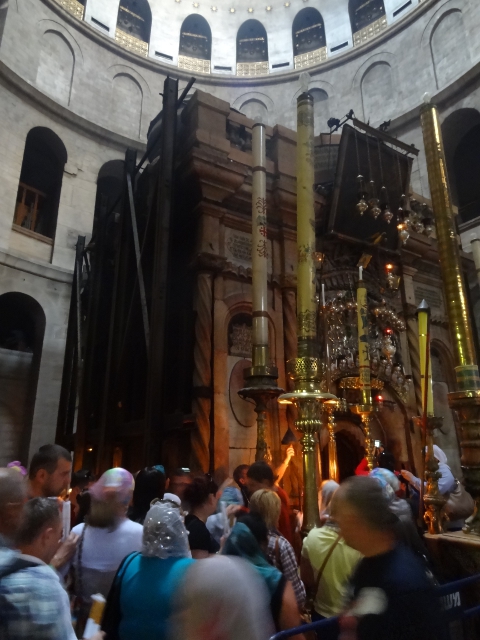
The site of the Resurrection. You can’t actually see it very well as it’s covered with tourists.
It’s also the central focus point of several different Christian sects, each with their own rituals. So for instance, in the entranceway is a small stone table, raised maybe half a metre from the ground. This is of importance to Greek Orthodox only, as they believe it is where Jesus was laid out after crucifixion and cleansed. No-one else does, and the tablet was only installed a couple of hundred years ago, but still … Elsewhere in the church is a ritualistic spot, accessed from two sides depending on whether you’re Catholic or Orthodox, where it is believed Jesus rose from the dead. very popular with people lighting candles – usually 33 at a time (to represent Jesus’ age at the time of death, obviously!). Interestingly, this is the reason it is forbidden to take candles to the Temple Mount.
Just outside the city walls lies the alleged site of the Last Supper, as well as the Garden of Gethsemane. The former actually lies within the old route of the walls (so at the time it, and the nearby Mount Zion, lay within Jerusalem, but when the Turks rebuilt the walls several centuries later, they ran out of money and cut that bit out!), but the latter as always been outwith the walls, and lies at the foot of the Mount of Olives. There’s a church there, and I walked in during a service, whoops, so I just stayed at the back, took a couple of unobtrusive pictures, stayed until a change in speaker, and then left quietly!
The biggest religion here though seems to be, somewhat ironically, the worship of money. Not only do the three major religions here all have pretty much the same principles, taken from a common origin (all of them, for example, believe that pretty much every major Biblical figure up to John The Baptist was some kind of major figure, and they do all have a specific focus on Abraham in particular), but they all seem to be in the market for selling tat, including postcards, t-shirts, and other touristy stuff. Granted some of the tat is specific (incense and candles are found generally in the Christian quarter for instance), but the streets are the same – narrow, hilly, lined with shops and full of people. Only the small and obscure Armenian Quarter is different – here the streets are wider, lined with pale stone buildings, and pretty much empty.

Typical city street in the ‘Old City’. What we really need here too is Smell-o-Vision!
One might well ask too, why would God choose Jerusalem? In actual fact, in ancient times, people tended to build temples at the highest point nearest to the village/town they were in, and the mount of Jerusalem lay just to the West of the first town here. Interestingly, ironically, and slightly worryingly, remains of the very first occupation of the Jerusalem area (the original ‘City of David’ and the original Jewish settlement) lie just to the South of the Temple Mount and the city walls, in what is now a majority Palestinian Arab area of East Jerusalem. Whoops …
Most of my route through the city was with a tour ‘group’; I figured it was easier to join one of the official city tours rather than make my way around alone. And it was just as well since otherwise I’d never have known the oddity of the opening hours of the Temple Mount, for instance! It lasted four hours, and we went round a lot of the stuff in the city. I’m not usually one for tours but sometimes they’re useful.
There’s a difference though between that, and the properly-organised tour party holidays – lots of people being herded from one point to another with only just enough time to take photos. The really bad ones are those where everyone wears, not just matching badges, but matching t-shirts!! We passed one early on on our route round Jerusalem – they looked like knobs!
In other news, last night I got accosted by some random (slightly cute, if a bit dumb) South African woman who borrowed my laptop and then later on beat me 3-0 at backgammon, despite her having only the vaguest knowledge of the rules. No I didn’t let her win – I’d say it was beginner’s luck. She was interested in playing again tonight, but so far she hasn’t actually seen me yet (the social lounge area in the hostel is a pretty big room!).
Also, I think I broke my camera flash. The flash itself still works, it’s just that the flash itself won’t rise up out the camera. may have to attack it later with a knife…
Day 12: Wednesday 27 February –
Stories of Faith and Devotion
“I have to say I was sorely disappointed, both with the quality of the rooms and with the level of customer service I received. I appreciate that it was a really busy time, but had hoped that some mitigation could have been made due to travelling with a heavily pregnant wife. Firstly, we booked a double ensuite room with cot. It was only when we got there that we found out that our initial room had been double-booked, and we were offered an alternative, of slightly lower quality but with aircon; it was only when we reached the room that we found the aircon was actually an entirely open side – the room was a cave. The ‘ensuite’ was a hollow in the cave edge that was filled with water, and a hole in the ground nearby. We were kept awake all night by the sound of animals in the stable next door, leading to my wife getting so stressed out that she gave birth in the night – a couple of weeks early, note – and were disappointed to find that no help came from reception, even when we tried ringing them. In addition, we had no mobile reception and the ‘free Wi-Fi’ connection didn’t seem to reach to the ‘room’. Although it’s in a superb location, I think we’d find it very hard to consider staying here again.”
Joseph of Nazareth, TripAdvisor Review for the ‘Inn at Bethlehem’, December 4BC.
Joseph, Mary, and Jesus would have had the better of the trip between Bethlehem and Jerusalem. Apart from the final entry to Jerusalem, it would have been a predominantly downhill journey of around 9-10km. And of course back then they wouldn’t have had a large concrete wall to be processed through. Although that said, knowing the Romans, I’m sure they could have built one in a couple of days, should they have had the need to. They would also probably have had better weather.
I made the trip, in reverse, in a shade over 2 hours. It was partly through ‘proof-of-concept’, and partly because I had nothing better to do! In olden days, it would have been a popular pilgrimage route, but today I’m pretty sure I was the only one walking the journey. It’s entirely possible I was one of the only people doing the journey at all – certainly at the, uhm, “border”, I was the only person walking through in my direction.
Ah yes, the “border”. Between Jerusalem and Bethlehem (actually, just on the Northern edge of Bethlehem town) lies a large concrete wall, maybe 8-10 metres high, topped with razor wire, with what I assume to be guard posts every so often. It’s really a rather bleak and ugly construction, with the lower (reachable) sections covered in graffiti – some pretty, some merely mindless vandalism, but most pretty political. This is the ‘technical’ internal boundary between Israel proper, and the ‘West Bank’ – one of the two areas controlled by the Palestinian Authority. (The other area is Gaza, run by a rival Palestinian faction. The two factions don’t like each other, and neither like Israel. This is partly why Gaza is much more violent than the West Bank, and why people generally don’t go there!).
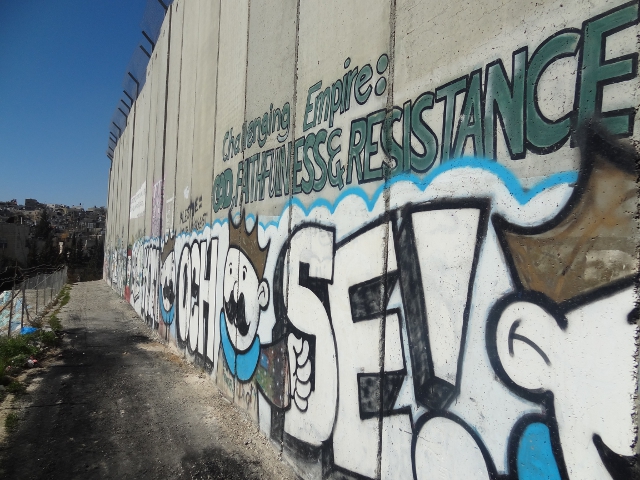
The chap who runs the hostel in Bethlehem is German and says it reminds him of Berlin. It’s quite a chilling thing.
Crossing the border from Israel to the West Bank was … trivial. The way through resembled the gates on entry to old-fashioned football stadia, with bare dark beige concrete, and metal turnstiles. There was no-one to guide me, no-one to handle me, I just walked straight through. Given that there are actually restrictions on entry (Israeli Nationals are not allowed to enter the West Bank), this surprised me. The only life was processing the trickle of people coming the other way, and the taxi drivers at either side who were determined to get me into a taxi, and were a little surprised when I told them I’d walked from Jerusalem and no, it’s not ‘two hours’ to Bethlehem from here, don’t be silly.
It feels as if there are actually two Bethlehems (three if you include the Israeli settlements on the edge of the town, but most people don’t…). One, the tourist city, is centred on Manger Square and is filled with shopping souks of religious tat and ornamentation, and English-menu restaurants. Many of the ‘roads’ are cobblestone-type lanes that are barely wide enough for the myriad of cars that pile through them. This all fades out at a small road junction to the West, where there is a large stone supplied by Cologne Cathedral as some kind of ‘friendship token’ (twice; the first one was destroyed during the Intifada in the early 2000s), and gives way to the Arab city centre of Bethlehem which is chaotic busy bustle, noise, smell, just like any other Arab city in the area. The difference is subtle, but very marked.
Interestingly, the signs, information, and displays are often in three languages: Arabic and English are the two most common (and of course Hebrew is nowhere to be seen at all), but the third language found with surprising regularity is French – not just in a ‘tourist’ capacity either but actually in some of the admin. One suspects that quite a bit of aid to Bethlehem has been supplied by the French government (or; a large set of steps in the town, the ‘Catholic Steps’, actually say that they were part-funded by the government of Belgium!).
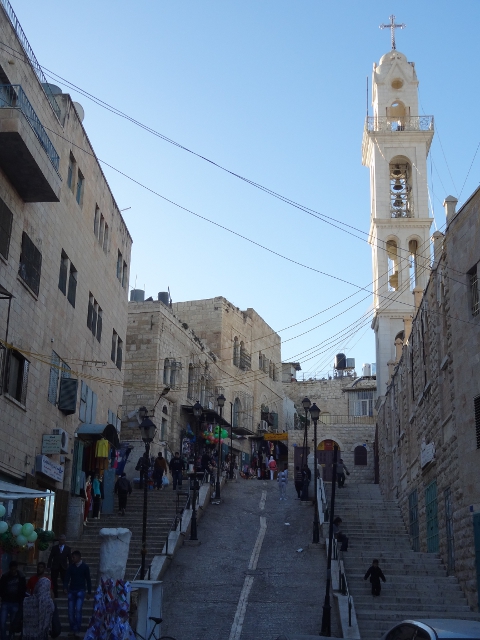
Part of the centre of Bethlehem – the tower is the Syrian Orthodox Church. Which was closed.
Bethlehem is, of course, famous for being the place where Mr J Christ esq was born, some 2,000 years ago. Not that you’d know it from being here…oh who am I kidding?! Now that the wall’s come in, a few shops/cafes close to it have turned their attention to that (the artist Banksy had done a few doodles in the area and on the wall, so right on the edge of the city there’s a restaurant that overlooks the wall called ‘Banksy Restaurant’, next to a similarly-themed shop. Almost certainly unofficial.), but for the most part everything in the Tourist area is geared towards religious symbols and artefacts, catering to all denominations!
I did go into the ‘Basilica of the Nativity’, relatively late in the afternoon once most of the tour groups had passed through. Even then, I still had to wait around for a couple of large groups to, er, stop singing religious chants in foreign languages (I think one group was German) before I could take a picture of ‘the spot’.
It’s quite a big church – it’s actually two churches in one, in practice, as there’s a larger church to St Joseph attached to the Nativity Church itself – but I’d imagine even so it still gets absolutely packed at pilgrim-time. Despite its size though, the most important spot, a small ‘grotto’ underneath the central aspect of the church, can’t hold that many people at a time. There, in an alcove underneath a line of candles, is an indentation in the ground that marks the very spot of Jesus’ birth. Just behind, and slightly lower, marks the location of the Manger where he slept that first night. From small acorns, big trees do grow.
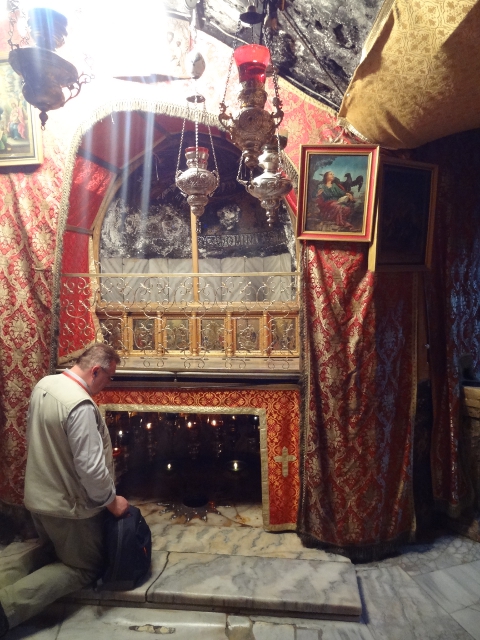
This is where it all began. Complete with believer.
Now, it feels weird as a tourist to wander there with a camera. I don’t mean that taking photographs is odd – after all that’s what pretty much everyone else was doing. What I mean is, that was all I was doing. I didn’t go there with any sense of religious fervour, it’s not a pilgrimage (on the door on the way in it says something on the lines of ‘Welcome! If you come as a tourist, we hope you leave as a pilgrim. If you come as a pilgrim, we hope you leave stronger in faith’), I didn’t come to kneel and pray at the spot, I merely came as a historian and an interested person. A random Palestinian in there asked me ‘Are you holy?’, to which I have to say that no, I’m not, and she was thus confused as to why I was there.
I didn’t feel anything. I guess it proves that if I have a religion, it’s not one that’s centred around worship; this was something I always felt anyway, but although I felt a ‘need’ to have come here, it wasn’t a ‘need’ driven by belief, rather it was one driven by knowledge and interest. Maybe that, in itself, is a pilgrimage?
There isn’t much else in Bethlehem, really, and much of what there is was, oddly, closed. I did see the ‘Milk Grotto’ – a church built on the site where some of Mary’s milk dripped onto the bare rock, and miracles sallied forth. It, like the Church of the Nativity, makes much use of underground caves, and it’s actually quite a pretty little church.
The other issue with Bethlehem seems to be that, since the tourist centre is driven largely by tour groups, the city’s only really active during the day. Restaurants were shutting around 5pm, which is inconvenient, because not many people stay the night here (they are usually bussed in from Jerusalem – indeed one whole level of Bethlehem Bus Station is devoted to parking for tour buses!). I’m staying in another backpacker hostel with four large dorm rooms (with 6-8 beds in them). I think one of the people who helps run it said that there were only about 2-3 other guests here tonight, and currently I’m in a 6-bed dorm on my own! It’s quite an interesting, friendly, hostel, and the profits from it go to local NGOs serving the local Palestinian community.
Not sure what my plans are for tomorrow. I was going to overnight in Ramallah, but the snag here is that there appears to be virtually nowhere to overnight in Ramallah at! There’s a few decent hotels but they all seem to be a few miles out of the town centre, in the heart of the countryside. There are no hostels, and the only notable guesthouse/B&B in the centre has been unrecommended to me by at least three sources! So I might end up staying here; my snag is that Friday afternoon is the start of Shabbat in Israel proper, and I ought to really be in Tel Aviv before then, else I might be stuck the wrong side of Jerusalem until Saturday. What makes things doubly complicated is that on Friday morning there’s the Jerusalem Marathon, and most of the roads in the centre of the city will be closed. Gaaah!
Day 13: Thursday 28 February –
The Wall Game
“People are people so why should it be
You and I should get along so awfully?”
Depeche Mode – People are People
Or, alternatively:
“And where there used to be some shops
Is where the snipers sometimes hide”
Human League – The Lebanon
Today’s scariest moment, a propos of everything else:
Being in a ‘serveece’, a shared taxi, going up the hill between Jericho and Bethlehem, jostling for position amongst the traffic as if at the start of a Grand Prix, only with cars coming down the hill right at you. Apparently weaving amongst the traffic and overtaking on blind bends with no barriers to protect the drop to the cliffs below is quite normal.
Elsewhere on the same road, you have the rather weird situation of two single-lane roads (one in each direction) separated from each other by bits of mountain suddenly join at the bottom of a hill into a fully-fledged dual carriage.
Today was another day of walking a lot, although some of it was me getting lost. And, being honest, Hebron is not a city you really want to get lost in. Indeed it was only until recently that the British Foreign Office were suggesting that it might actually be a city you wouldn’t want to be in at all. But they wuss too much.
That said, in general you know you’re going to somewhere with a bit of ‘history’ when there’s a big red signpost at the turn-off that says, in three different languages, words to the effect of “This road leads to a Palestinian town. It is forbidden, dangerous to your lives, and against Israeli law for citizens of Israel to enter”. In actual fact it’s forbidden for Israelis to enter the West Bank at all, unless presumably they’re passing through on one of the many roads and are not stopping, but that only explains half the story, and is specifically relevant to Hebron.
There is a term used in the media: “illegal settlements”. Now, it’s not pushing any POV to state that this is true – Israeli settlements in the West Bank are illegal under Israeli law. But that doesn’t stop there being any. The majority of them are on the fringes of Palestinian towns (as highlighted yesterday with Bethlehem – I can see them from the hostel balcony but they’re a good couple of miles beyond the city limits), but in a couple of towns/cities in the West Bank, they’re, shall we say, ‘a little closer’.
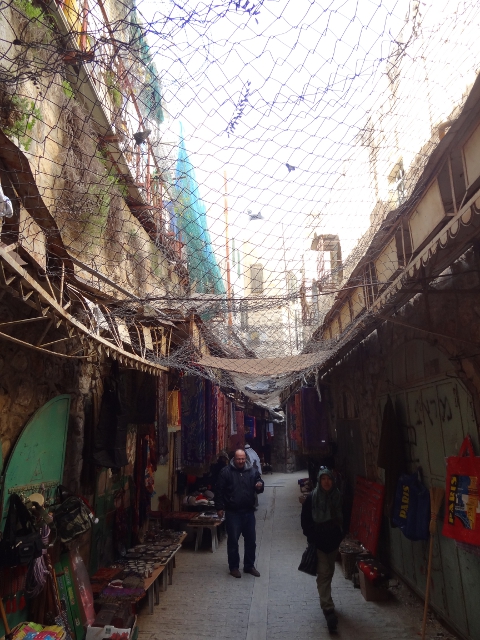
Shops, protected from above. And if you look closely, you can see rubbish and stones trapped above
The wire mesh fence above the souks prevent whatever is thrown from above from landing on the streets below. The settlers seem to be quite violent, and appear to react without (much) provocation. In addition, the presence of Israeli security towers means that the closest buildings to the settlers are often designated uninhabitable, or at least not fully usable – I actually went into one Palestinian house with a rooftop terrace that overlooked a couple of settler buildings. So close, and yet so very different.

On the roof of a Palestinian house in the centre of Hebron. That square concrete building on the right is an Israeli Settlers building.
Interestingly, many Israelis hate them, and everything that they stand for. It seems a large proportion of these ‘settlers’ are actually immigrant Jews from places like the USA, who seem to have taken it upon themselves to recolonise the Holy Land. And the Israeli government are very reluctant to criticise them, due to not wanting to be seen as being ‘weak’ in the face of the Arabs and the concept of the Israeli state covering the whole of “Israel”.
The Arabs hate them as well, of course, as they’re infringing on land that by rights laid down by peace accords, should be ‘Palestinian’. This is why, in Hebron, the settler village has around 4 soldiers for every settler. And yes, that is the right way round.
However, Hebron has an additional issue that heightens the tension even more. It is the alleged burial place of Abraham, and many of his family. This means that this area (“The Tomb of the Patriarchs”, although it’s interesting how very few people have heard of it called by that name – the Muslims call it ‘Al-Khalil’, the Jews call it by a Hebrew name which I can’t currently remember) is one of the holiest sites in the region for both religions. And of course neither of them are going to give it up, despite the fact that they are worshipping the same person. This is much more bitter and angry than the Dome of the Rock/Western Wall issue in Jerusalem, this is pure hatred (one settler in the 1990s massacred 20 or so Muslims waiting in line at the tomb to enter the mosque on their side, whilst back in 1929 one Muslim massacred a number of Jews in the same area). So now the whole area is protected by Israeli security forces, barbed wire fences, and …
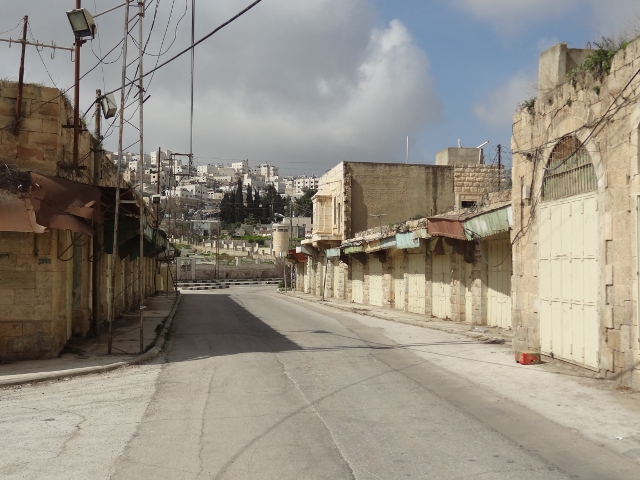
This town, becoming like a ghost town …
Part of the very centre of Hebron, which used to be market stalls and shops, is now designated as a ‘no-go’ area. Part of it is simply roads where all the shop fronts have been welded shut and no-one’s allowed to live, but part of it is actually designated ‘no-man’s land’ where no-one is even allowed to visit. There are security troops, with guns, on most of the corners of the streets in these areas, and checkpoints are a-plenty. It’s really quite bizarre, and very … quiet. It’s not quite ‘scary’, but it certainly feels a bit post-apocalyptic.
My introduction to Hebron was quite bizarre; the ‘service taxi’ arrived at the ‘bus station’ and I hadn’t a clue where I should be going next (I couldn’t easily source a map), so a teenage boy on the service guided me to the centre of the city (via a couple of cellphone shops; he needed something on his phone repaired) – this despite neither of us speaking the other’s language. We did have a shared habit though – he also cracked his knuckles. He could also crack his neck, which is just weird on another level. I still managed to get lost and accidentally meandered through to the Jewish sector (where not a soul was to be seen at the checkpoint). This is where I encountered the ghost town streets, and again managed to get lost because no-one seemed to be able to direct me the proper way (this partly because one of the streets I needed to go down was a ‘no-man’s land’ street and the directions to avoid it were “confused”). I eventually managed to find my way to Abraham’s tomb – via the Jewish entrance rather than the planned Muslim entrance. It’s quite underwhelming, actually, cos the tomb’s in a cave below the building that you can barely see, so all that’s left on the Jewish side is a small synagogue, but still that’s not the point…
Coming out the synagogue back the way I came, I encountered another badly-manned checkpoint, and got ‘picked up’ by a young Palestinian chap who makes a bit of money on the side as a casual ‘tour guide’ to Hebron. So he took me round the Arab part of the city, and told me about life from his point of view. He didn’t seem terribly hopeful about the immediate future, but did suggest that a Third Intifada (uprising) would probably be a bad thing as the Israelis would then take even more control.
My afternoon was a bit more ‘sane’; I won’t say ‘relaxed’ as it involved a lot of walking. I went back to Bethlehem, and from there took another ‘serveece’, this time East (rather than South) to the ancient city of Jericho.
Jericho has been inhabited for at least 8,000 years, in one form or another. One of the tourist sites on the North-West side of town (2km) is ‘Tel al-Sultan’, which is the excavated remains of evidence of the earliest civilisations here. Now, to me, it just looked like a bunch of rocks, but I did take a few pictures for people like my friend Sarah (Greebocat) who can probably tell me exactly what a big hole in the ground dated to 6,000 BC represents … (!) This is also presumably the location of the city walls that were destroyed by Joshua, had Joshua been living at the right time that the city walls were archaeologically proven to have fallen down (there’s about a 400 year differential).
Opposite is Ein Al-Sultan, a natural spring and the water source for these ancient city dwellers. Also nearby is the cable car up to the Monastery in the hills. This cable car touts itself as, get this, ‘the longest cable car below sea level’. I suspect there’s a lot of competition for that title …
On a side, pedantic, note: if a mountain starts below sea-level, is its peak calculated from its base position, or from sea level itself? I presume the former, as if the latter occurred, you could have a 400m high mountain listed with a negative height!

Overview of Hisham’s Palace, with nice scenery in the background. Pretty setting, isn’t it?!
About 2km NE, or 3km North of the town centre, is the archaeological site of ‘Hisham’s Palace’. This was an Umayyad ‘palace’, destroyed by an earthquake in 748AD, but partly then rebuilt and reoccupied for another couple of hundred years. They’re actually still excavating it so there’s a lot still unknown about the site. The Umayyids were the Muslim rulers of the whole of the Arab world, one of the first Islamic dynasties in fact, and it is also they who were responsible for the building of the Dome of the Rock in Jerusalem, for instance.
Although there’s not much of the site left, what there is is actually weirdly impressive, given everything else. And, although I am sick to death of them, there are still a couple of fab mosaics in situ, kept locked behind gates.
There’s not much to Jericho town itself; it’s main use is as a transport hub to serve places like Ramallah, and also the Allenby/King Hussein Bridge into Jordan, the only accessible border crossing to Palestinians, to which Jericho is the nearest town (it’s only a handful of km away).
Getting back from Jericho proved the most time-consuming trip, as I had to wait for maybe 20-25 minutes for enough people heading in my direction to make a service taxi viable. In the event, I was the only one going to Bethlehem – the others were all going to Hebron, to the Al-Khalil mosque, so at the turn-off about 3km from town, another taxi was hailed for me so they could continue on their way. I managed to find somewhere to eat in Bethlehem after 6pm, which impressed me, though how soon they were to close I couldn’t honestly say. Just off Manger square too.
Finished up with a bottle of Palestinian Real Ale – from the Taybeh brewery somewhere near Ramallah. It’s quite hoppy, and foamy, but pleasantly drinkable. I was actually originally planning on being in Ramallah this evening (which would have been a much easier journey from Jericho), but there are virtually no places to stay in the town itself, and there’s not many people with available couches on Couchsurfing, so I’m back in Bethlehem this evening. Still not sure what to do about tomorrow, but suspect I’ll be Tel Aviv-bound!
Day 14: Friday 1 March –
Beat the Clock
Yet another insane bus journey today.
The bus wasn’t even supposed to go on that route, but due to the Jerusalem Marathon closing the main road from Jerusalem to Bethlehem, the bus had to take a different series of roads. And a full-sized coach should not be going up and down twisty, steep, narrow roads through out-of-town neighbourhoods. The views were good but sometimes I felt that we may have been a bit close to them! Plus the bus was standing room only – it was just leaving as I arrived, and was full of Arabs heading to the Dome of the Rock for their Friday prayers.
The Jerusalem Marathon was partly the reason why I was getting the bus. I could have walked back but wasn’t sure the road would be open. In fact it wasn’t until I got partway through Bethlehem that I found out the buses themselves were running. I was tempted to get the serveece to Ramallah and then a bus from there, but figured that was far too much hassle!
My issue was that the roads would reopen by about midday, but Shabbat meant that my last bus was at 4pm, so it was a question of how best to spend my time.
In the event it was all pretty easy. I wandered out the hostel in Bethlehem at around 9am, discovered that Bethlehem doesn’t generally open until mid-morning so breakfast was a mint tea back at the border wall (which even there I had to wait for because they hadn’t fully opened even by 10am!), then got lost trying to find the checkpoint again (hey, small roads hemmed in by concrete walls are ten-a-penny round here!).
Finally had something to eat in Jerusalem Old City, and by the time I headed towards the bus station, it was about midday and the marathon was just packing up! Had a nice smooth wander to the bus station, caught the regular bus to Tel Aviv and got there by 2pm. Walked to the hostel and then just chilled out for the rest of the day with two of the other people in my dorm room – Jonathon from the USA (and Exeter), and Carla from Germany.
That all makes the day sound really boring. It was. It was quite low-key and relaxed; I didn’t really do a heck of a lot else apart from walking and travelling. It’s definitely feeling like I’m coming to the end of my holiday. I wasn’t rushed at any point, I’ve just had a relaxing day.
Of course, chatting with, and wandering around a dark Shabbat-ed Tel Aviv (which isn’t as closed as, say, Jerusalem would be), with Jonathan and Carla has meant I’ve had quite a nice evening, friendly and casual.

My Hostel in Tel Aviv. You can’t miss it …
The hostel, apart from being bright yellow on the outside (!), is actually pretty cool, although quite limited with facilities. I’m hoping it has a printer so I can print my boarding passes for my flights! [my flight is at 5am on Sunday morning. I’m still not sure what I’m going to do tomorrow, but the hostel will let me store my luggage most of the day]!
Day 15: Saturday 2 March –
Candyfloss and Oranges
I seem to have changed skin colour.
This is actually the exact opposite of this time last year, when my sun-tan lotion turned me a rather smurfy shade of blue. This time, a lack of suntan lotion seems to have turned me dayglow red. This is slightly embarrassing, as you can imagine – of course one might argue that this makes me more like a stereotypical Brit abroad (except that I kept my shirt on at all times). In my defence, it is supposed to be Winter, and Winter in Israel is supposed to be relatively cold – I was advised on temperatures around 15ºC, 20 if I was lucky. Today, the electronic indicator on one of the buildings in Tel Aviv said it was 24ºC …
The other thing I was led to believe is that Tel Aviv doesn’t do Shabbat that much. I have to say that, er, it does. Many years ago, I visited a penpal in Llanelli, South Wales for a weekend (this was in 1996. She quite fancied me. After I politely rebuffed her, she ended up preferring women anyway. Make of that what you will), and she saw me back to the coach station in Swansea on the Sunday afternoon – virtually nothing was open, at all. Tel Aviv today was, surprisingly, a bit like that. I had always been under the impression that if anywhere in Israel didn’t do Shabbat, it was Tel Aviv. The streets were deserted, and virtually nothing was open.

The suburbs of Tel Aviv. Wouldn’t you like to live here … ?
It’s hard to say what the residential suburbs of Tel Aviv look like. I likened them to taking the Serbian city of Novi Beograd, and transplanting it into the English county of Surrey. I realise however that this is a metaphor that virtually nobody I know would understand (being as I don’t know anyone who’s been to both Novi Beograd and Guildford!), but … imagine a quiet, tree-lined street that oozes money, and then hide behind the trees a concrete apartment block. It’s the nearest I’ve ever found to pretty concrete!
A bit of an amble North and I discovered where all the people were. First off was the park, well, a long area of parkland, grass, and play areas along either side of the Yarkon River. This was full of walkers, picnic-ers, a few people in small rowing boats paddling down the river … a very typical summery parkland scene. At its Western end, the river surroundings give way to the sea, and to Tel Aviv ‘Port’. This area of shops, restaurants, seaside views, and fishing spots, was where everyone was, all milling around the waterfront, eating, watching circus-like acts performing, or just sitting watching the boats sail in and out of the harbours.
The seafront at Tel Aviv stretches for about 3 and a half miles, from the Tel Aviv port in the North, to the suburb of Jaffa in the South. Apart from the port itself, and the occasional break, it’s pretty much seaside and sandy beaches all the way down. There’s actually quite a few different ‘designated’ beach types; so for instance partway down is a small beach that’s used primarily by dog-walkers, whilst a bit further on still is a beach prime for surfers. Only one (area of the) beach is actually ‘separated’; this by a large wooden fence. This is the beach for the ultra-orthodox Jews, and it has specific designations (so on certain days of the week it’s men-only, on others it’s women-only, etc).
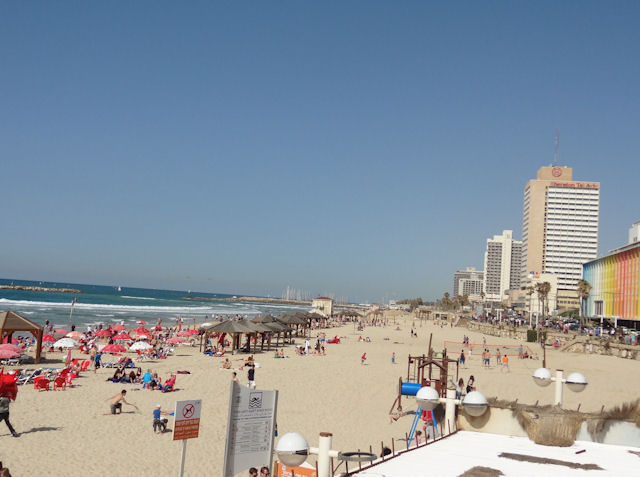
The Tel Aviv beachfront. Now imagine what it’s like in Summer!
The beaches differ in width, surface, and attractions – some (like the dogs’ beach) are quite narrow whilst others stretch out for a fair way. At some there are cafes actually on the beach itself. Some are separated from the promenade by rock formations, others are pretty open. All of them were pretty busy today with sunbathers, games players and the like (one of the more popular games on the beaches seems to be some form of ‘tennis’, but played with a smaller, harder, ball and oversized table-tennis bats). I didn’t see anyone selling candyfloss, alas, otherwise I might well have grabbed some! I did venture onto one of the beaches at one point, only briefly, just so I could say that I had. I’m not aware of having set foot in the Mediterranean Sea before; I’ve sailed across it, and I’ve certainly been in its vicinity quite a bit, but for the avoidance of doubt, I did paddle anyway!
The beaches end at Jaffa, an old port and one of the oldest parts of Tel Aviv – a town having been here since long before Crusader times. It’s even mentioned in mythology – just off the coast are the rocks that Andromeda was allegedly chained to before Perseus rescued her. It’s also a more Arab part of town, so one would have thought that Shabbat would have been less noticeable here. However, in actual fact it was rather hard to tell; the cafes were full to bursting point with both locals and tourists, but they were the similar sort of beachfront cafes I’d been seeing along the whole walk.
Jaffa is a little calmer though, as a suburb, as it’s full of quaint old narrow streets flanked either side by old stone buildings – it was nice to wander through them to escape from the hubbub of the seafront. The art galleries selling paintings were all open, but there’s no way I’d have been in the market to import pictures from abroad!
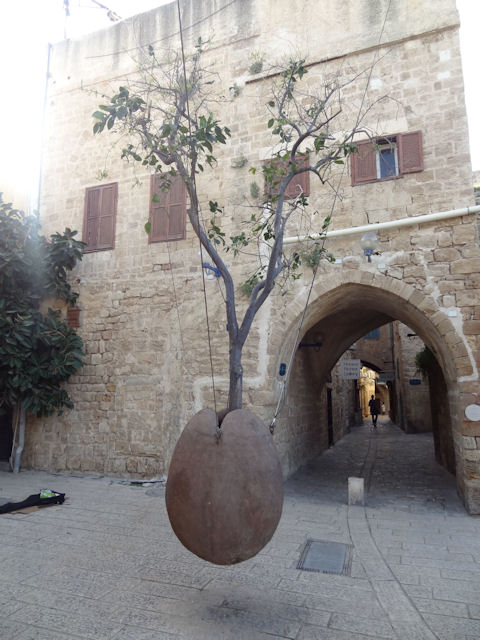
The ‘floating orange tree’, in the centre of Jaffa. Nope, no idea either!
Apart from to do something with Shabbat, my aimless wandering served to waste some time before meeting up with Carla and Jonathan again – I’d arranged to meet them back at the hostel just after 5pm (which, conveniently, is the time that shops started to re-open). Because of my stupidly early flight in the morning, I wasn’t going to overnight again in the hostel, so kind of needed something to do this evening, and they very kindly offered to walk, chat, and eat with me! They finally went to bed a little after 11pm-ish, which suited me fine as then I could casually wander over to the airport.
The ‘bus’ from just outside the hostel actually went to the bus station rather than the central train station, as I’d been advised that it did, but no matter, there’s another train station nearby. I got there just before midnight, and the next train from this station (indeed the only one all night) would leave just after 1.15am … yay for having a large book to be able to read! (More trains left from the main central railway station, but that was 2 miles away, and buggered if I were going to walk that!). Felt strange to know my holiday was almost over though!
I have to say though, that when I was lying in bed this morning, in the dorm bed, before I got up, I actually thought to myself ‘I belong here’. Not specifically in Tel Aviv, but rather I belonged in the dorm hostel, on the move; that I kind of ‘belonged’ when I travelled. Like some kind of ‘Littlest Hobo’.
One gripe I do have about dorms in hostels is that where they have bunk beds, I often seem to be stuck in the upper bunk. And climbing up and down the metal ladders barefoot in the dark isn’t the easiest, safest, or healthiest activity. Grrr!
Day 16: Sunday 3 March –
Every Day is like Shabbat
I titled this diary “Finding my Religion”. It thus seems rather apt that the very last touristy place (*) I visited on the holiday was a large, traditional, Anglican cathedral, on a Sunday. There were no services being held at the time (although one was due within the hour). Large, serene, quiet, imposing, overbearing even, and ‘classy’. Not overly-kitsch like the churches in Nazareth, not full of overbearing style like the Hagia Sofia, and not covered with hordes of tourist-pilgrims like Bethlehem. This was Ely, in Cambridgeshire, England: old-fashioned cathedral charm.
The very last place I visited on my travels was actually a riverfront pub in Ely. Hey, I have priorities!!
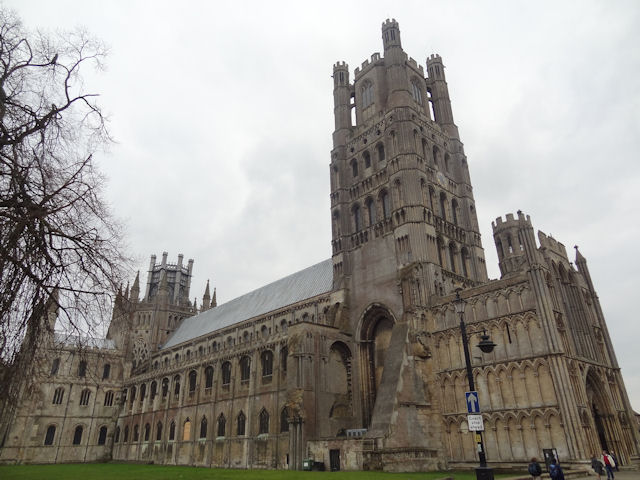
Ely cathedral. It’s a cathedral. In England. They all look similar …
As far as I’m aware, no-one terribly significant is buried here, and as cathedrals go, it’s not the most well-known. But I like cathedrals; I find them quite pretty; and in any case it’s about the only reason to come to Ely!
It’s quite a quiet market town, with only a couple of (fairly long, granted) streets of shops: mainly small artisanal shops, cafes, and charity shops. It’s quite an ancient city, being built on a slightly higher piece of land surrounded by flat plains – in the old days they’d have been marshlands. This part of England is tending towards being below sea-level, and much of the land around has been ‘reclaimed’ from water by centuries of drainage procedures. As a result, it’s quite flat and pretty boring to ride through on a train.
I was here because my flight was due to arrive into Stansted Airport around 12.30pm, and the cheapest trains back to Nottingham (on advance tickets) weren’t until after 5pm. Plus I’d never been to Ely so I thought I might as well have a wander to see what the town was like.
Today being Sunday, it was a proper ‘day of rest’, and the scene on the riverfront in Ely was very reflective of that – canal boats moored up or sailing quietly over the water, people walking on the footpath slowly, admiring the view, birds chirping in the background that could easily be heard as there was no traffic or industrial noise. The only thing missing was church bells (which would come later) and the sound of leather on willow, but it is Winter, honest, despite my experiences of the past two weeks, and the cricket season is still a couple of months away.
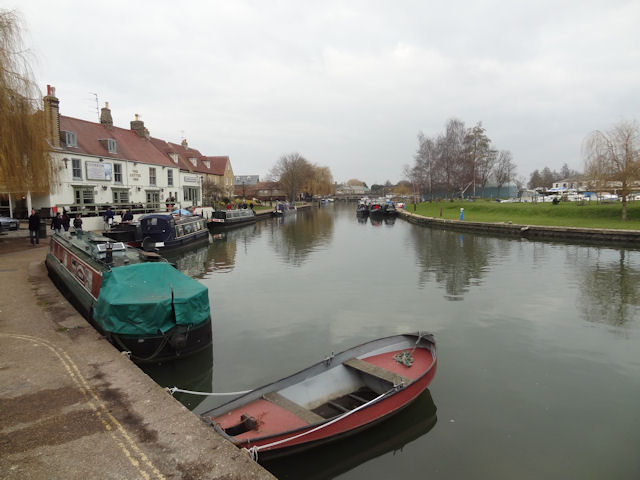
Ely riverfront. Where did the sun go?! :p
Of course today didn’t start off this peaceful!
I reached Tel Aviv airport around 1.30am (it was only about a 10-minute train ride from the station) – although my flight was a little after 5am, this is Israel and “you need quite a lot of time to go through check-in”. In actual fact it took me an hour. It’s quite amazing just how in-depth the check-in procedure is, but my main query (which I didn’t get a chance to ask because everyone seemed to be a bit busy and was rushing everywhere) would have been ‘why are you so anal about people leaving by plane, when it’s quite clear you don’t give a stuff when people leave by land?’. Suggestion to anyone who wants to come to Israel – fly out of Amman. 😀
Check-in procedure included taking everything out of my bag and scanning it, seemingly individually. Interestingly they never made any comments at all about the fact I had a ‘teach yourself Arabic’ book in it – one imagines however that they wouldn’t have been so impressed with the book I left in Bethlehem about security violations in Hebron! They did ask me where I’d been, and if I’d met anyone while here – they got confused (and a little peeved by my answers) when I said that I’d been to Israel and left again and then came back. Evidently they didn’t care what I’d done the last time I was here. I didn’t mention that I’d been to Palestine. Nor did they seem to pick up on the fact even though I would have had some receipts in my bag from Bethlehem. They were also confused as to why I only had hand luggage. My answer of ‘I wanted to see if I could’ didn’t seem to please them, but they didn’t pursue that line of enquiry any further anyway!
They also scanned me. This involved being led away to a quiet area in an office, behind a security curtain, and being made to empty everything from my pockets, including the snotty handkerchiefs, yes. It also involved me having to unzip my trousers so they could get their detector thingy right to my boxer shorts. And a hundred gay man suddenly think of porn movies.
Oddly, after all that, they let me though without any further questioning. I’m not actually sure what they could have done anyway if they weren’t happy, since I was already leaving the country, and one assumes if they didn’t like me, they’d want me to leave quickly anyway? It’s all rather confusing, really!
I spent most of the two flights back trying to sleep (I’ve never found it easy to sleep on planes), and most of the time in both Tel Aviv and Istanbul airports trying to get rid of my foreign currency (I’ve never ate quite as well in airports as I did today!). This was annoyingly because at the railway station, the ticket machine didn’t like my 20 shekel note so I had to use the 100, and it gave me change in coinage, which I’ve always found more difficult to exchange. So I spent most of it instead! The duty free souvenir shop in Tel Aviv priced everything in US dollars, which confused everyone trying to shop there, but apparently this is normal (it’s so normal, in fact, that I’ve never seen it before. Usually I end up seeing shops like that pricing everything in Euros. Not that I go to duty free souvenir shops in airports very often!).
And that’s pretty much that! The journey was uneventful, and I made it back home around 9pm. I’d eaten well in the riverside pub in Ely, possibly too well as I spent the journey home on the train feeling very bloated, so when I got home I didn’t feel like eating and wasn’t long to bed.
A summary will follow … at some point!